Acoustic Impact of Hybrid-Electric DEP Aircraft Configuration at Airport Level
Abstract
:1. Introduction
- The evaluation of the aerodynamic pressures on the full configuration via a medium-fidelity aerodynamic solver;
- The evaluation of aeroacoustic performances and hemispheric noise fields, using the Ffowcs Williams and Hawkings (FW–H) approach;
- Generation of noise–power–distance database through a ray-tracing approach;
- Acoustic impact at airport level evaluation with Aviation Environmental Design Tool (AEDT) procedure.
2. The Numerical Solvers
2.1. Aerodynamic Solver
2.2. Aeroacoustic Solver
2.3. NPD Calculation Methodology
- Ground reflection was active, and considered a perfect reflector;
- The Doppler effect ws active, to better consider the consequent atmospheric absorption;
- Atmospheric absorption was active, in fulfillment of the SAE-ARP 866B standard [16];
- A-weighting for the source spectra was active, in fulfillment of SAE AIR 1845 [3], for the NPD calculation.
2.4. AEDT Approach and Regulations
- day period: from 06.00 to 20.00;
- evening period: from 20.00 to 22.00;
- night period: from 22.00 to 06.00.
- T0 is the product of the number of seconds of the part of the day for which the descriptor is defined and the number of days, NTr, for which basic-scenario air traffic is defined (in this case NTr = 365);
- Nday,Nevening, and Nnight are the aircraft noise events that occur during the specified reference time period, T0;
- t0 is the reference time of 1 s.
- LAE is the A-weighted sound exposure level (SEL), defined as the constant sound level having the same energy in one second as the original noise event, computed for the time during which the sound level is 10 dB below the maximum level:
2.4.1. Selected Airport: Naples’ “Ugo Niutta Capodichino” Airport
2.4.2. Selected Airport: Turin’s “Turin-Caselle” Airport
3. Description of the Aircraft Configurations
3.1. Baseline Configuration (Configuration A): Propeller
3.2. Baseline Configuration (Configuration A): Airframe
3.3. Hybrid-Electric Configuration (Motorization 2): Propeller
3.4. Hybrid-Electric Configuration (Motorization 2): Airframe
3.5. Description of the Test Conditions for the Hemisphere Generation
4. Analysis of the Results
4.1. Aerodynamic Results
4.1.1. Configuration A
4.1.2. Motorization 2
4.2. Aeroacoustic Results
4.2.1. Configuration A
4.2.2. Motorization 2
4.2.3. Comparison
4.3. The NPD Database Generation
4.4. Airport Acoustic Impact Assessment
4.4.1. Capodichino Airport: Single Operations
4.4.2. Capodichino Airport: Cumulative Operations
4.4.3. Turin Airport: Single Operations
4.4.4. Turin Airport: Cumulative Operations
4.4.5. Comparison of Results
5. Conclusions
- Configuration A: the baseline configuration consists of a simplified version of the ATR42 regional aircraft equipped with two thermal engines, located in the proximity to the fuselage;
- Motorization 2: the hybrid-electric configuration consists of a modified version of the ATR42 regional aircraft with a new wing of equal length and higher aspect ratio, two tip propellers powered by thermal engines, aiming at reducing the induced drag, and a DEP system comprised of four propellers per side, powered by electric motors.
- The evaluation of the aerodynamic pressures on the full configuration via a medium-fidelity aerodynamic solver;
- The evaluation of aeroacoustic performance and a hemispheric noise field, using the FW–H approach;
- The generation of noise–power–distance (NPD) databases by a ray-tracing approach;
- The evaluation of the acoustic impacts at the airport level by AEDT procedure.
Author Contributions
Funding
Institutional Review Board Statement
Informed Consent Statement
Data Availability Statement
Acknowledgments
Conflicts of Interest
References
- PROSIB—Capitolato Tecnico ARS01_00297. Propulsione E Sistemi Ibridi per Velivoli ad Ala Fissa E Rotante; Ministero dell’Istruzione, dell’Università e della Ricerca: Rome, Italy, 2018. [Google Scholar]
- Aversano, R.; Bianco, D.; De Vivo, L.; Sollazzo, A.; Barbarino, M.; Federico, L. Acoustical Characterization of the F-35A Joint Strike Fighter: Results and Perspectives of the First Experimental Campaign; Institute of Noise Control Engineering: Madrid, Spain; ISBN 978-84-87985-31-7. ISSN 0195-175x. Available online: http://www.sea-acustica.es/fileadmin/INTERNOISE_2019/Fchrs/Proceedings/2003.pdf (accessed on 11 January 2021).
- SAE. Procedure for the Calculation of Airplane Noise in the Vicinity of Airports; SAE AIR 1845A; SAE International: Warrendale, PA, USA, 2012. [Google Scholar] [CrossRef]
- ICAO Annex 16 Vol. 1 “Aircraft Noise”. Available online: https://store.icao.int/en/annex-16-environmental-protection-volume-i-aircraft-noise (accessed on 11 January 2021).
- Visingardi, A.; D’Alascio, A.; Pagano, A.; Renzoni, P. Validation of CIRA’s Rotorcraft Aerodynamic Modelling SYStem with DNW Experimental Data. In Proceedings of the 22nd European Rotorcraft Forum, Brighton, UK; 1996. Available online: https://dspace-erf.nlr.nl/xmlui/handle/20.500.11881/3171 (accessed on 13 January 2021).
- Visingardi, A.; Dummel, A.; Falchero, D.; Pidd, M.; Voutsinas, S.G.; Yin, J. Aerodynamic interference in full helicopter configurations: Validation using the HeliNOVI database. In Proceedings of the 32nd European Rotorcraft Forum, Maastricht, The Netherlands, 12–14 September 2006; Available online: http://hdl.handle.net/20.500.11881/1080 (accessed on 13 January 2021).
- De Gregorio, F.; Visingardi, A.; Iuso, G. An Experimental-Numerical Investigation of the Wake Structure of a Hovering Rotor by PIV Combined with a G2 Vortex Detection Criterion. Energies 2021, 14, 2613. [Google Scholar] [CrossRef]
- Casalino, D.; Genito, M.; Visingardi, A. Numerical Analysis of Airframe Noise Scattering Effects in Tilt Rotor Systems. AIAA J. 2007, 4, 45. [Google Scholar] [CrossRef]
- Morino, L. A General Theory of Unsteady Compressible Potential Aerodynamics. NASA CR-2464. 1974. Available online: https://ntrs.nasa.gov/citations/19750004821 (accessed on 13 January 2021).
- Casalino, D. An advanced time approach for acoustic analogy predictions. J. Sound Vib. 2003, 4, 583–612. [Google Scholar] [CrossRef]
- Pagano, A.; Barbarino, M.; Casalino, D.; Federico, L. Tonal and Broadband Noise Calculations for Aeroacoustic Optimization of a Pusher Propeller. AIAA J. Aircr. 2010, 3, 47. [Google Scholar] [CrossRef]
- Casalino, D.; Barbarino, M.; Visingardi, A. Simulation of Helicopter Community Noise in Complex Urban Geometry. AIAA J. 2011, 49, 1614–1624. [Google Scholar] [CrossRef]
- Barbarino, M.; Petrosino, F.; Visingardi, A. A High-Fidelity Aeroacoustic Simulation of a VTOL Aircraft in an Urban Air Mobility Scenario. Aerosp. Sci. Technol. 2021, 107104, 1270–9638. [Google Scholar] [CrossRef]
- UNI-ISO 9613-2:2006. Acoustics—Attenuation of Sound During Propagation Outdoors—Part 2: General Method of Calculation. Available online: http://store.uni.com/catalogo/norme/root-categorie-ics/17/17-140/17-140-01/uni-iso-9613-2-2006 (accessed on 13 January 2021).
- ICAO. Doc 9501. Environmental Technical Manual: Volume I—Procedures for the Noise Certification of Aircraft. Available online: https://store.icao.int/en/environmental-technical-manual-volume-1-procedures-for-the-noise-certification-of-aircraft-doc-9501-1 (accessed on 18 January 2021).
- SAE. Standard Values of Atmospheric Absorption as a Function of Temperature and Humidity; SAE ARP866B; SAE International: Warrendale, PA, USA, 1975. [Google Scholar] [CrossRef]
- De Vivo, L. Model for Aircraft Noise Impact Analysis in a Reference Airport, PROSIB Project, Deliverable D3.3.2. December 2020. [Google Scholar]
- Legge 26 Ottobre 1995, n. 447 “Legge Quadro sull’Inquinamento Acustico”. Available online: https://www.gazzettaufficiale.it/eli/id/1995/10/30/095G0477/sg (accessed on 18 January 2021).
- Decreto Ministeriale 31 Ottobre 1997 “Metodologia di Misura del Rumore Aeroportuale”. Available online: https://www.gazzettaufficiale.it/eli/id/1997/11/15/097A9090/sg (accessed on 18 January 2021).
- Decreto Legislativo 194/2005 “Attuazione Della Direttiva 2002/49/CE Relativa Alla Determinazione e Alla Gestione del Rumore Ambientale”. Available online: https://www.gazzettaufficiale.it/eli/id/2005/10/13/05A09688/sg (accessed on 18 January 2021).
- Crocker, M.J. Handbook of Noise and Vibration Control; John Wiley & Sons: Hoboken, NJ, USA, 2007; p. 15. ISBN 978-0-471-39599-7. [Google Scholar]
- University of Napoli, Leonardo Divisione Velivoli, PROSIB D2.1.5—Progetto preliminare e MDO velivolo motorizzazione 2, PROSIB project. September 2020.
- Pagano, A. Progetto e Verifica Elica per Velivoli con Ala Convenzionale della Classe ATR42-Ottimizzazione Elica—Design and Verification of Propellers for Conventional Wings of the ATR42 Aircraft Class—Propeller Optimization (in Italian), PROSIB project, deliverable D2.1.2. December 2019. [Google Scholar]

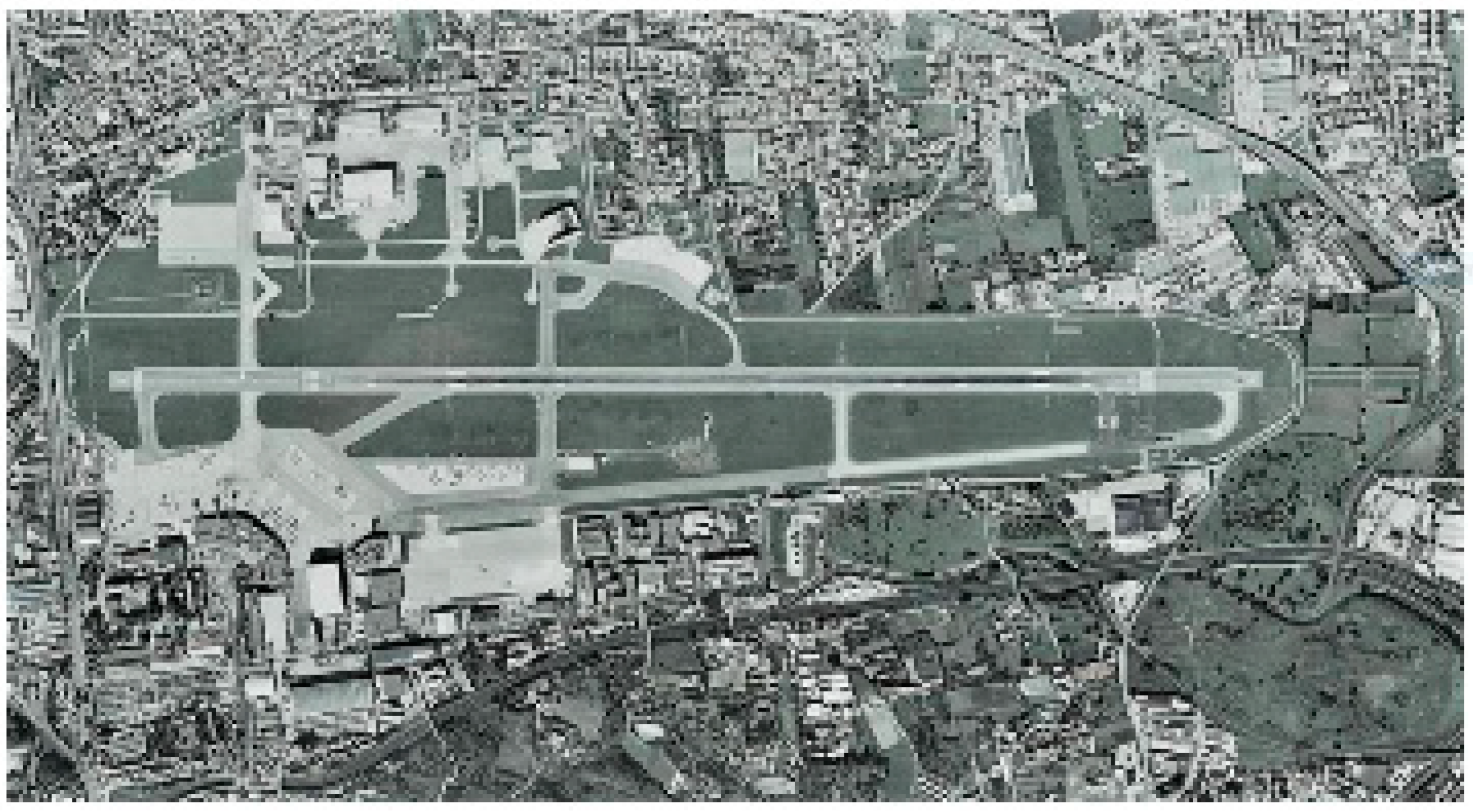

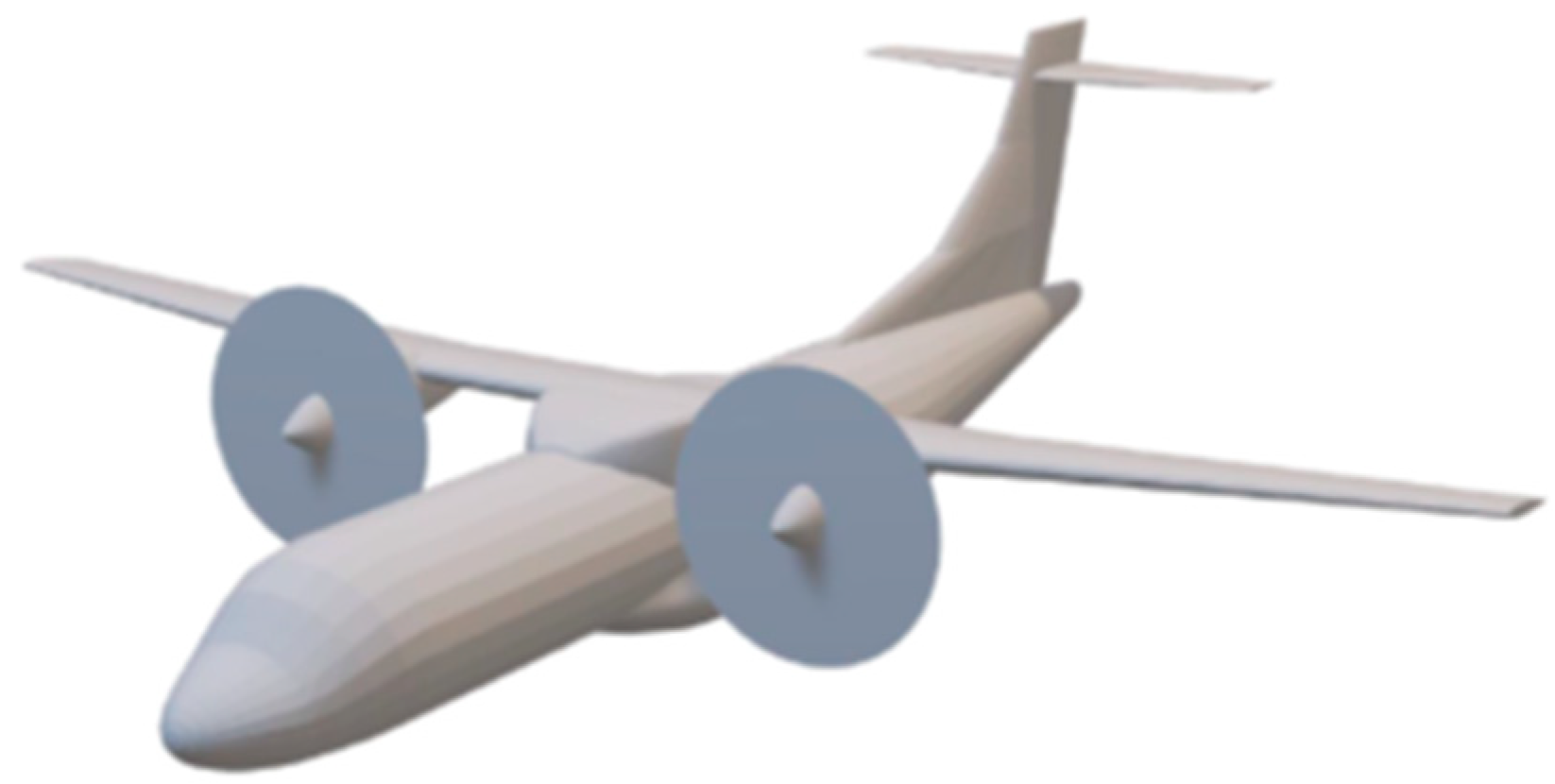
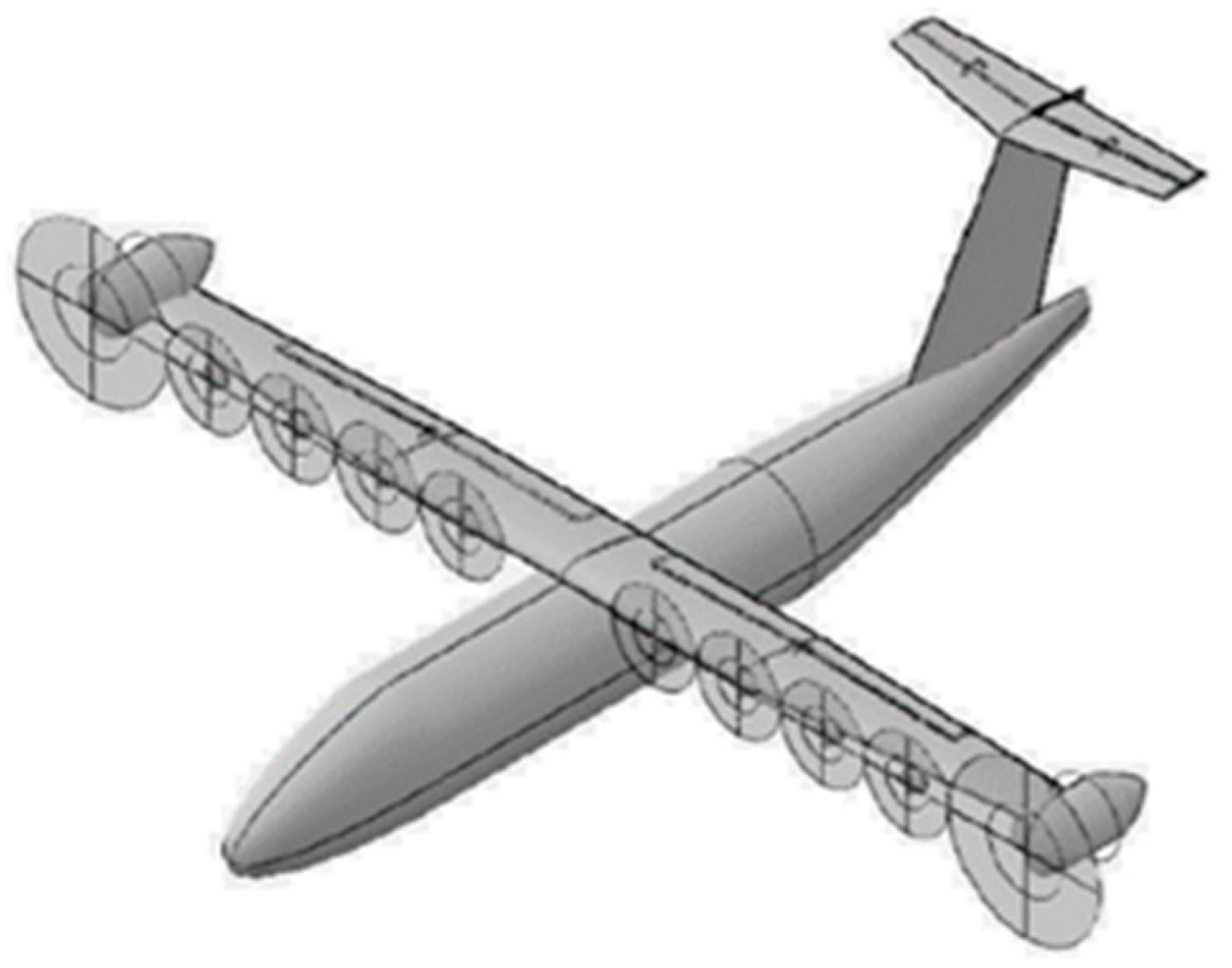
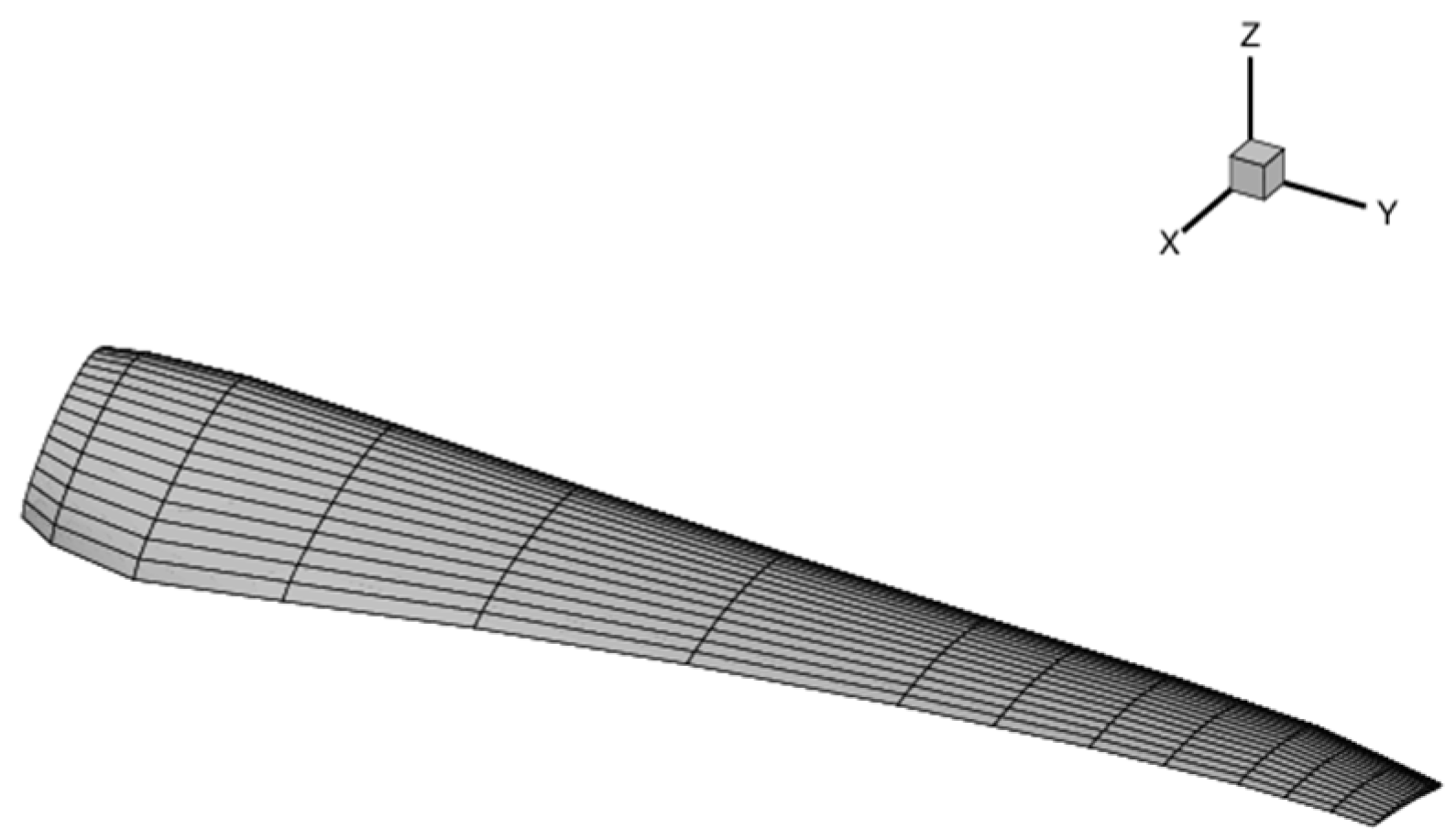
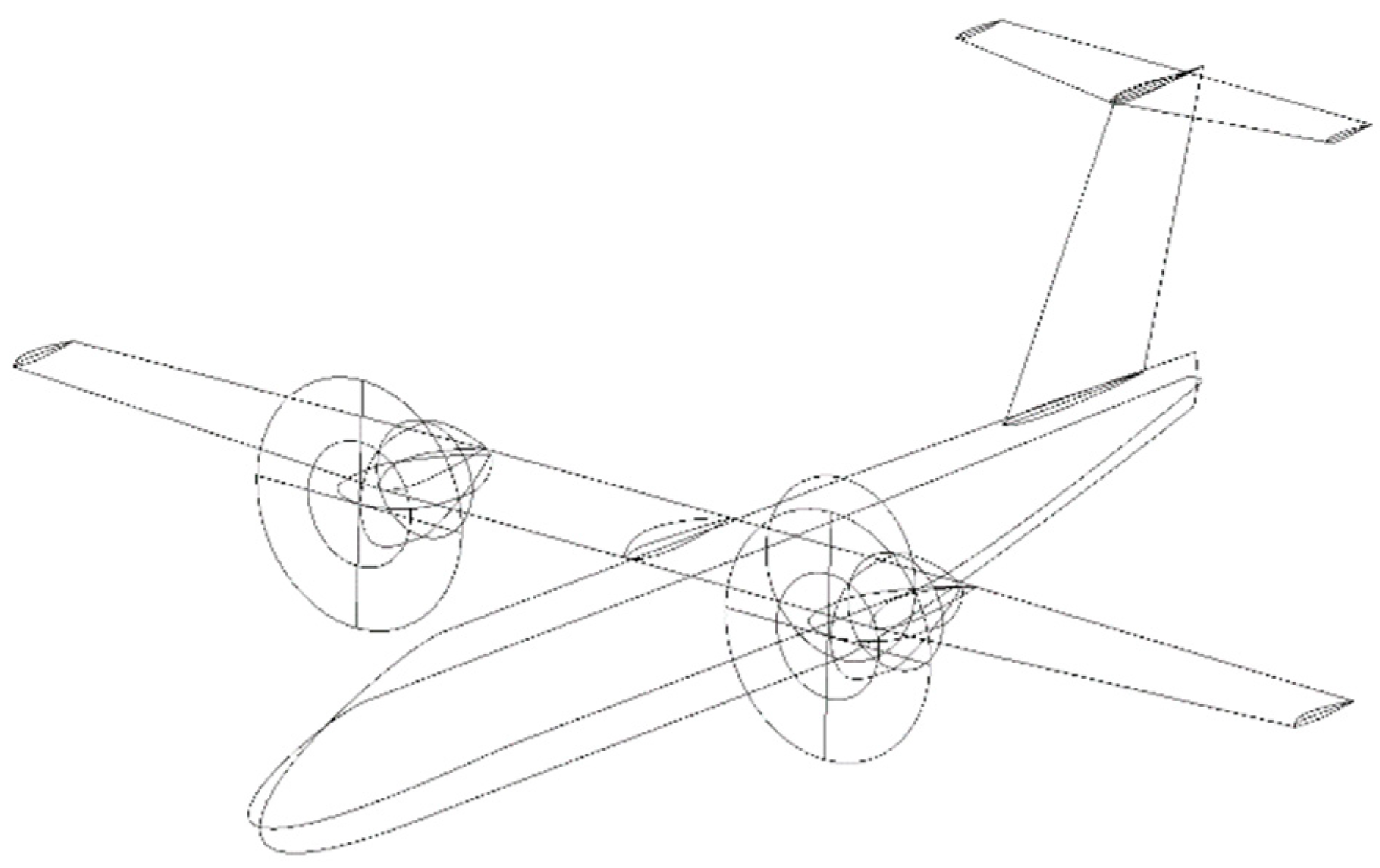


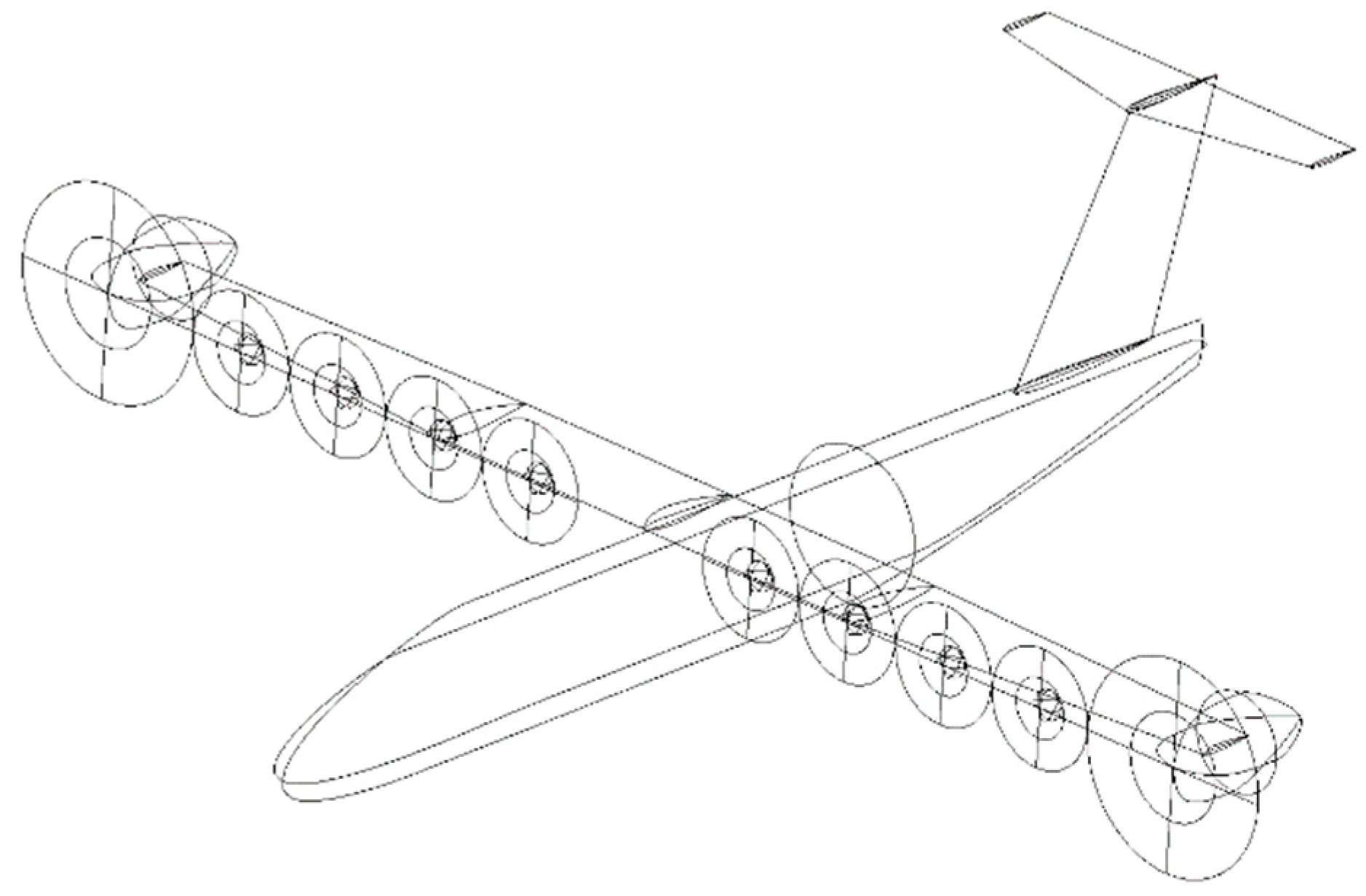
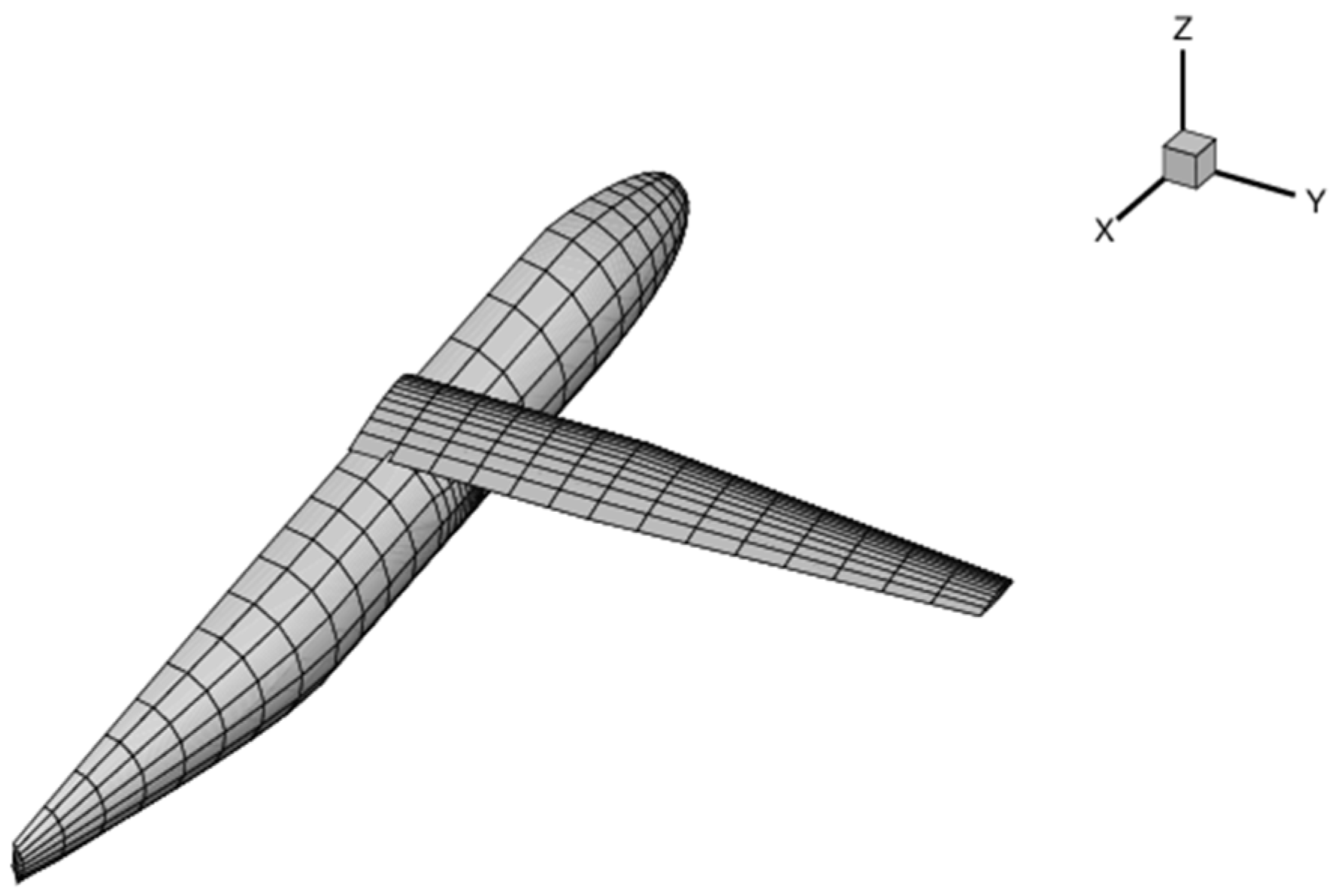
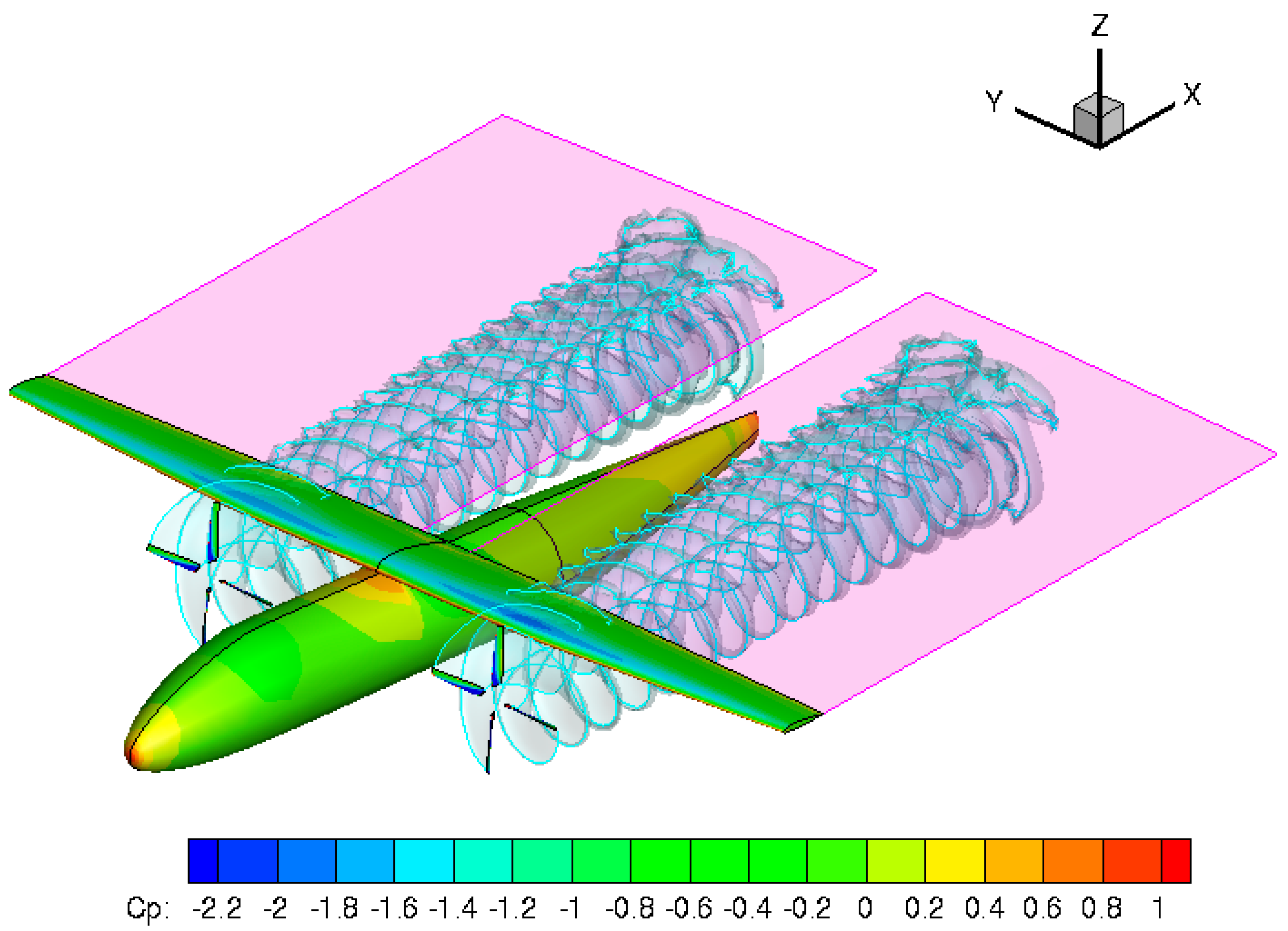

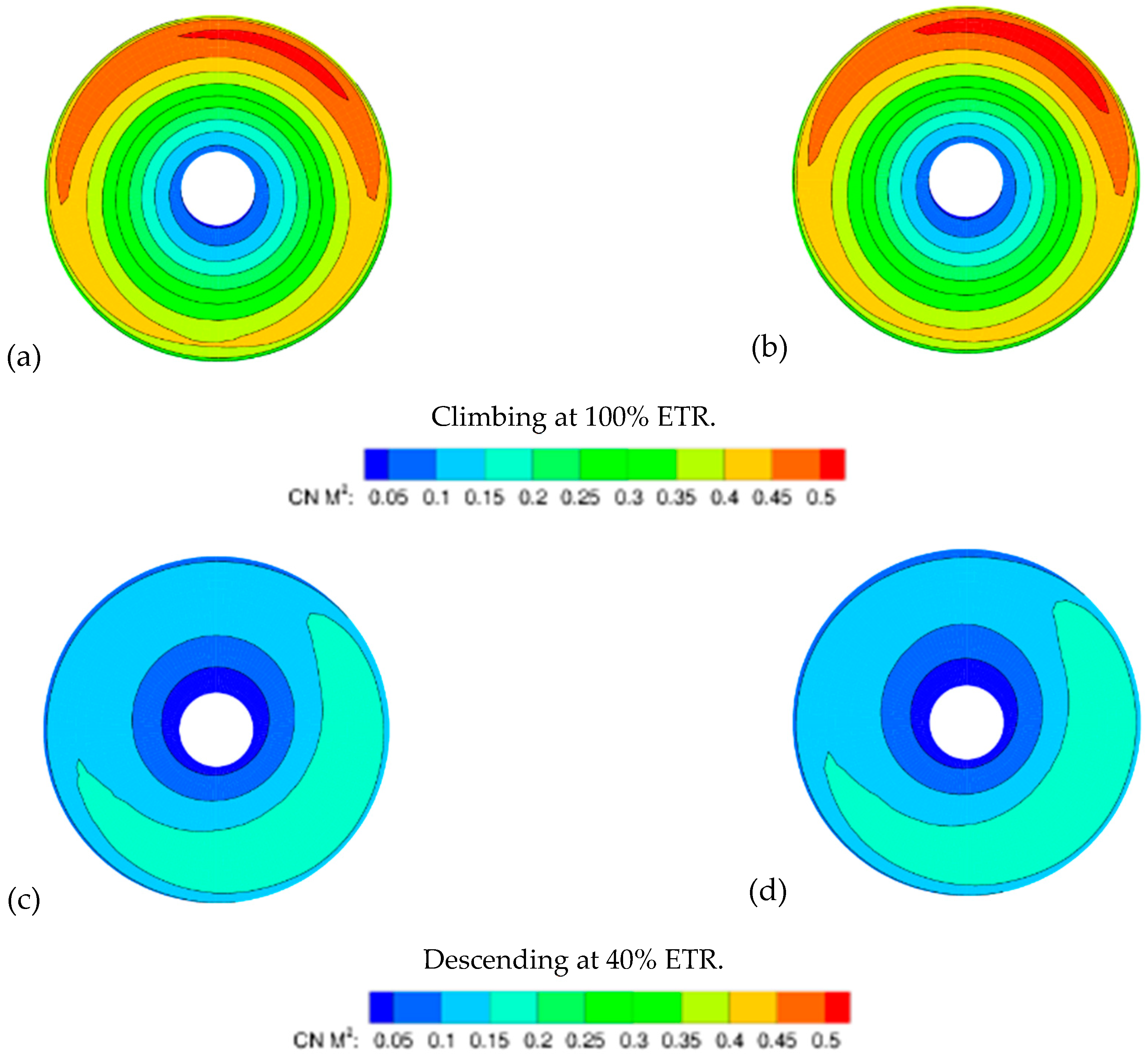


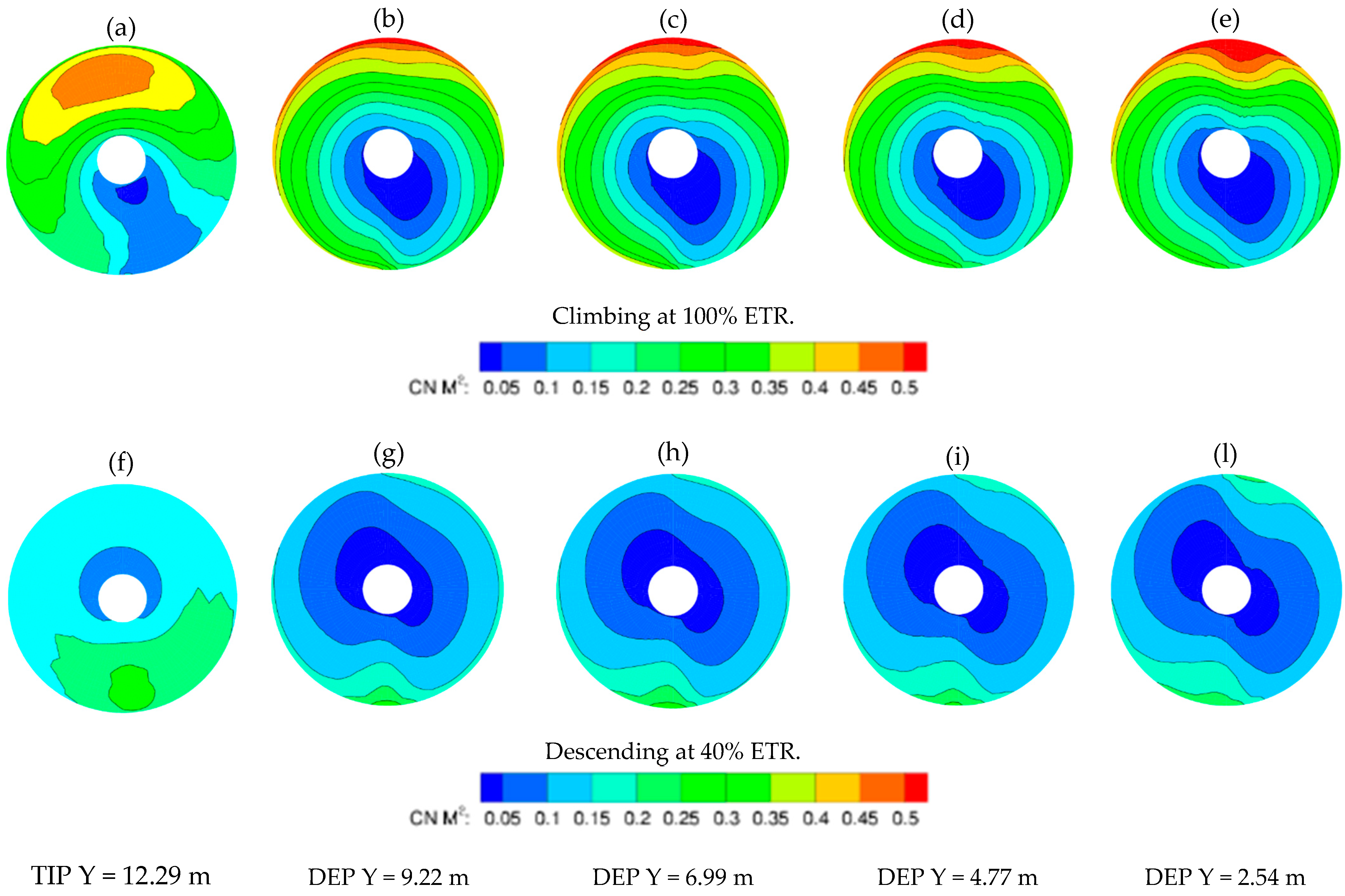


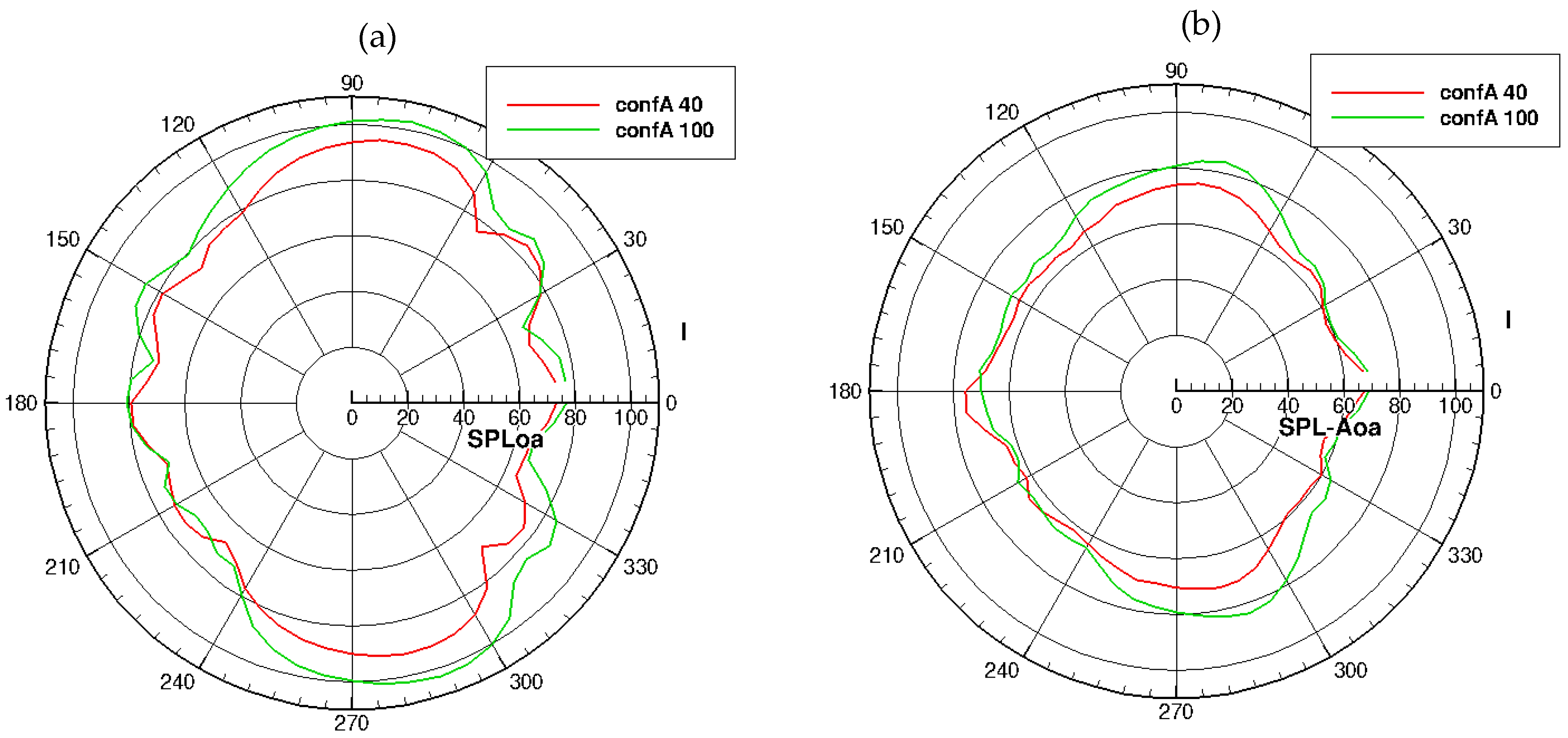
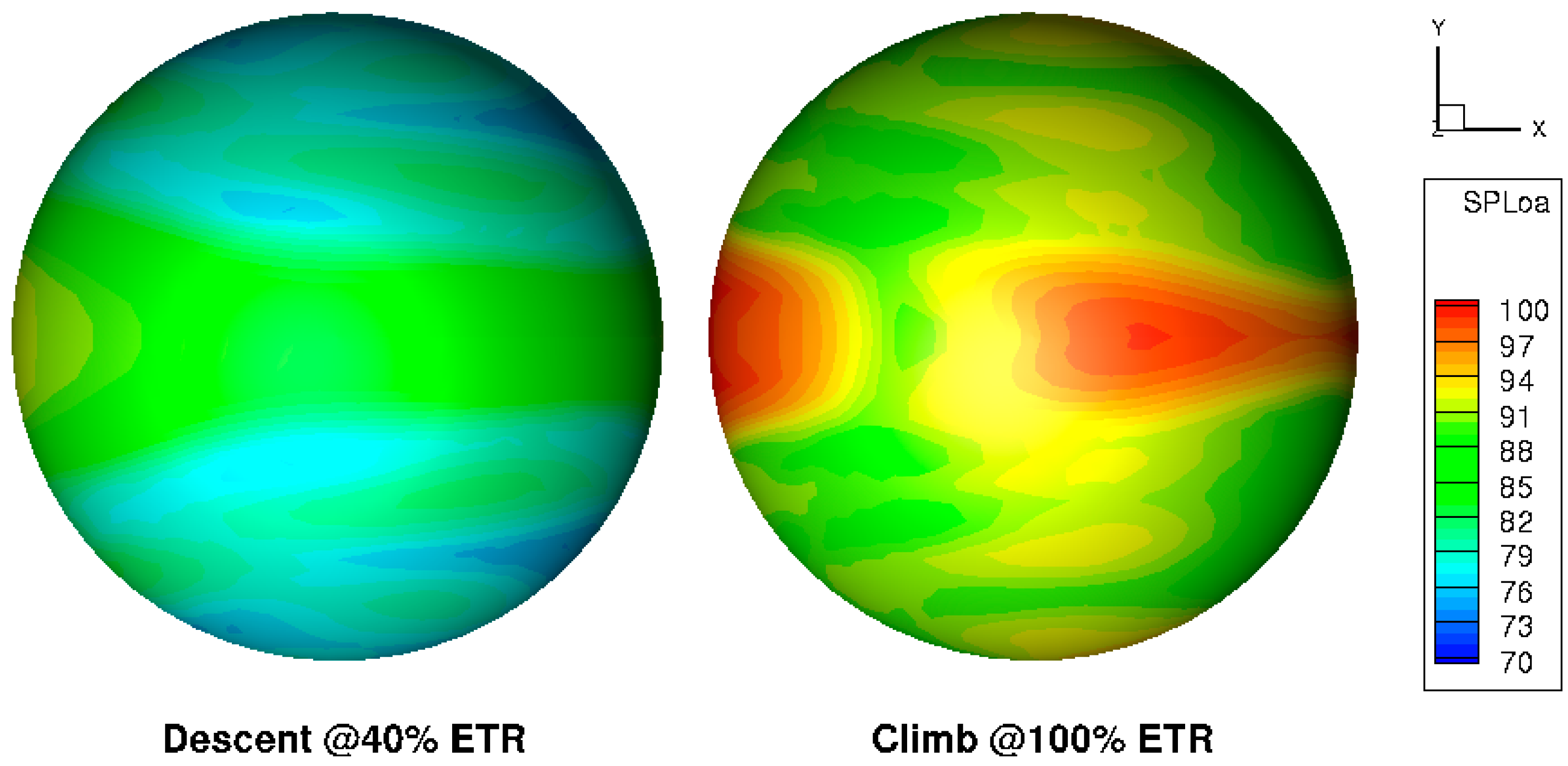

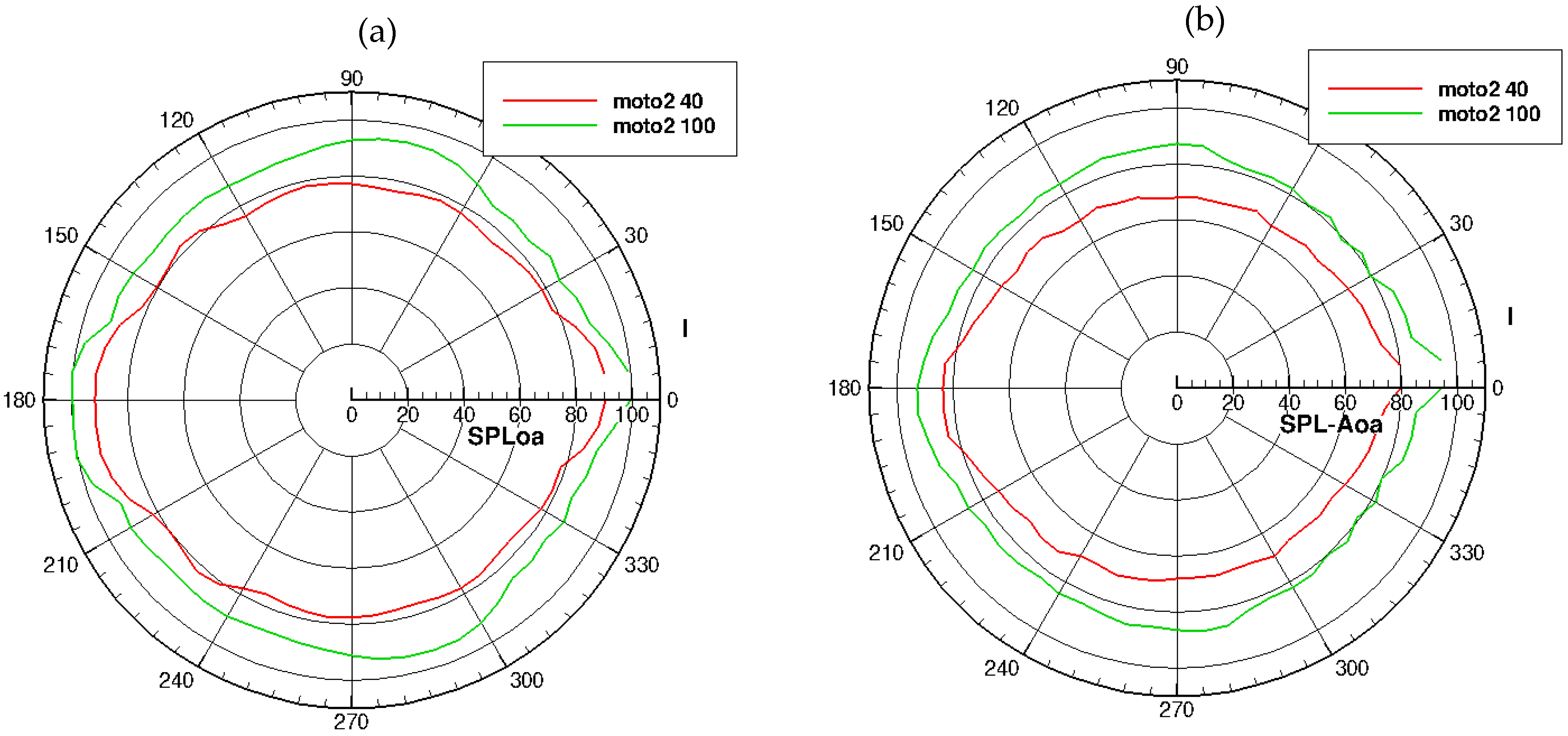
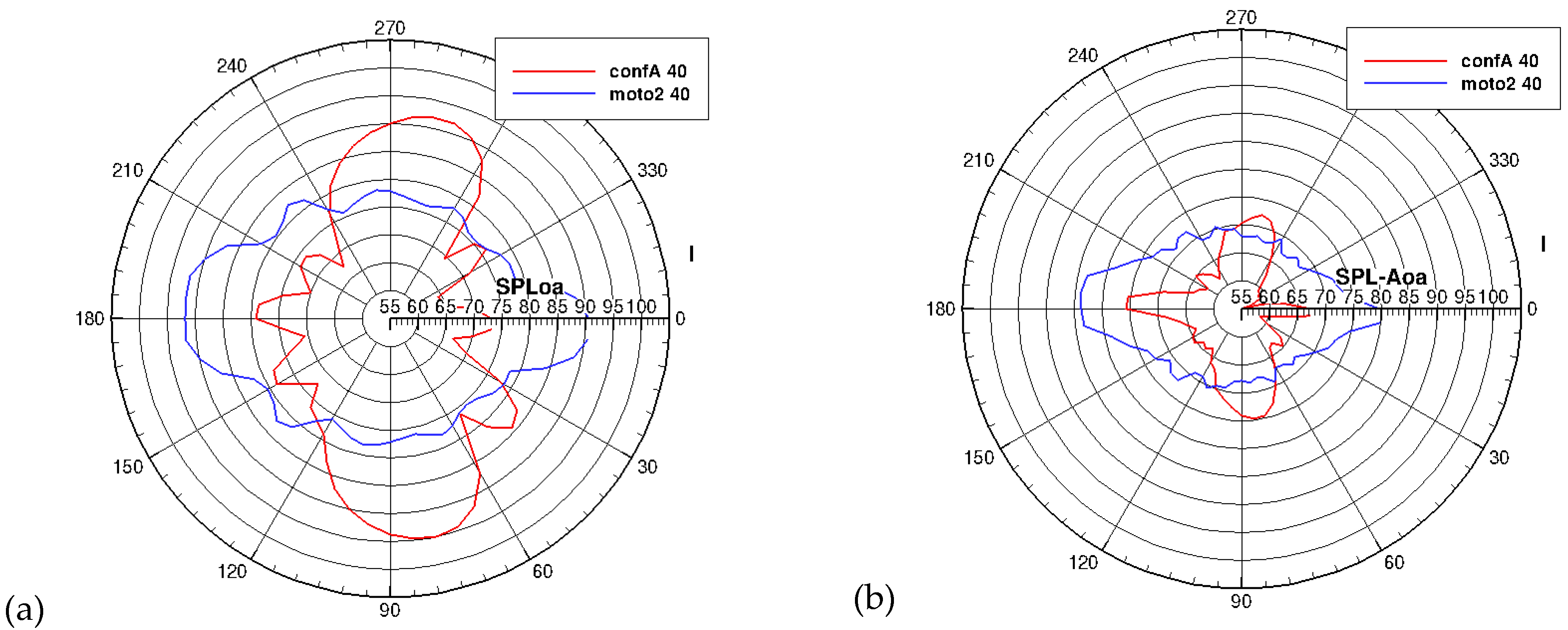
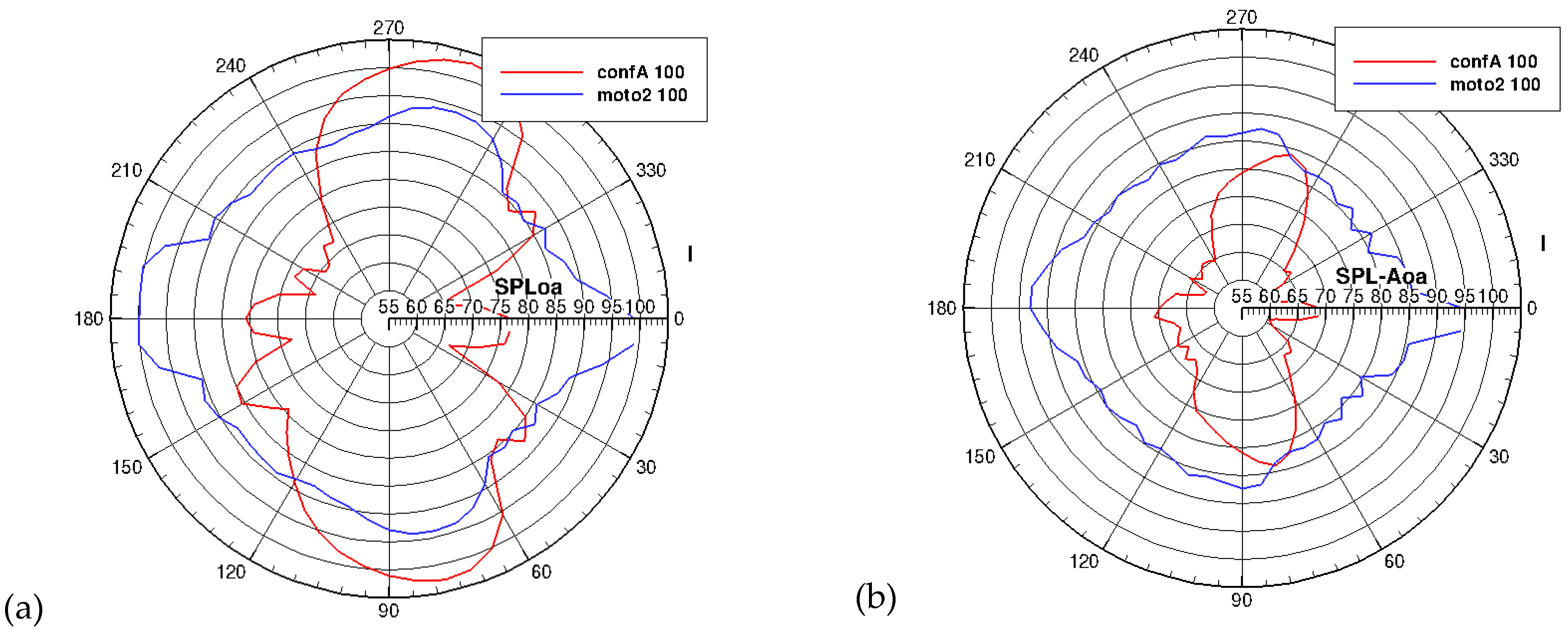

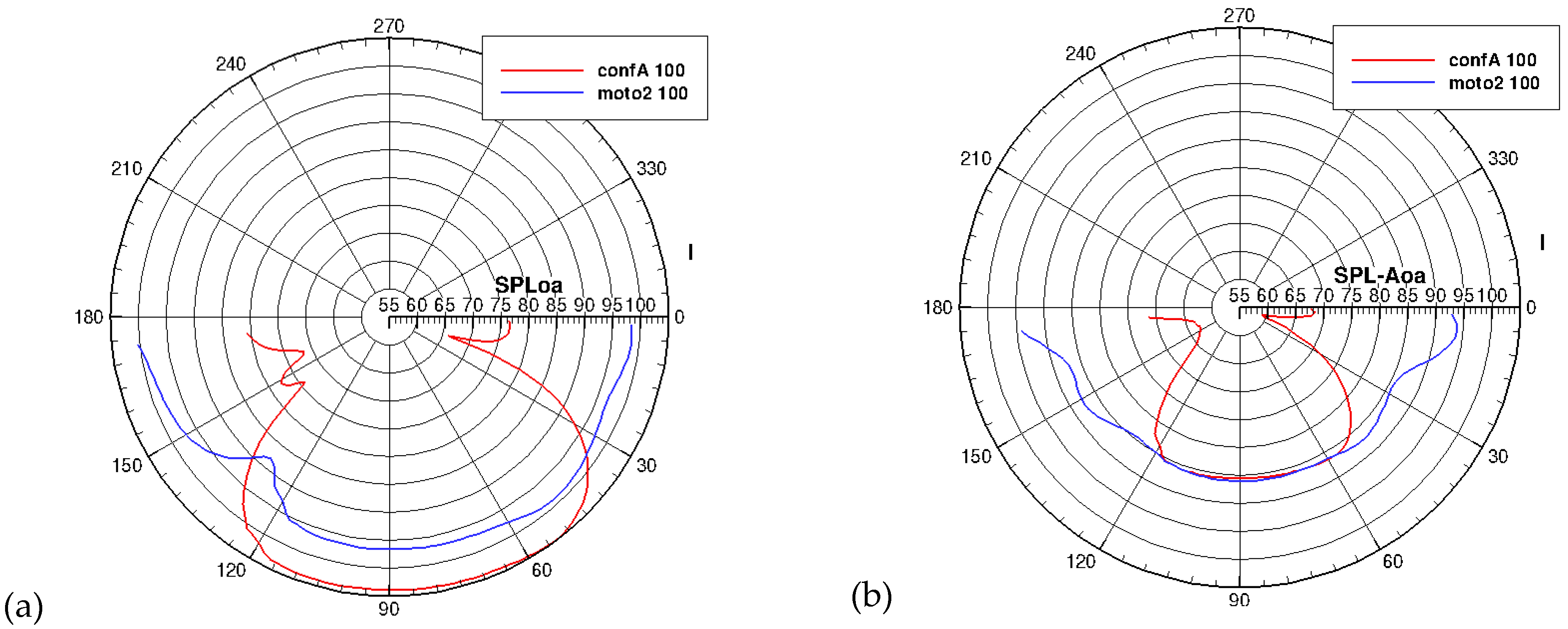
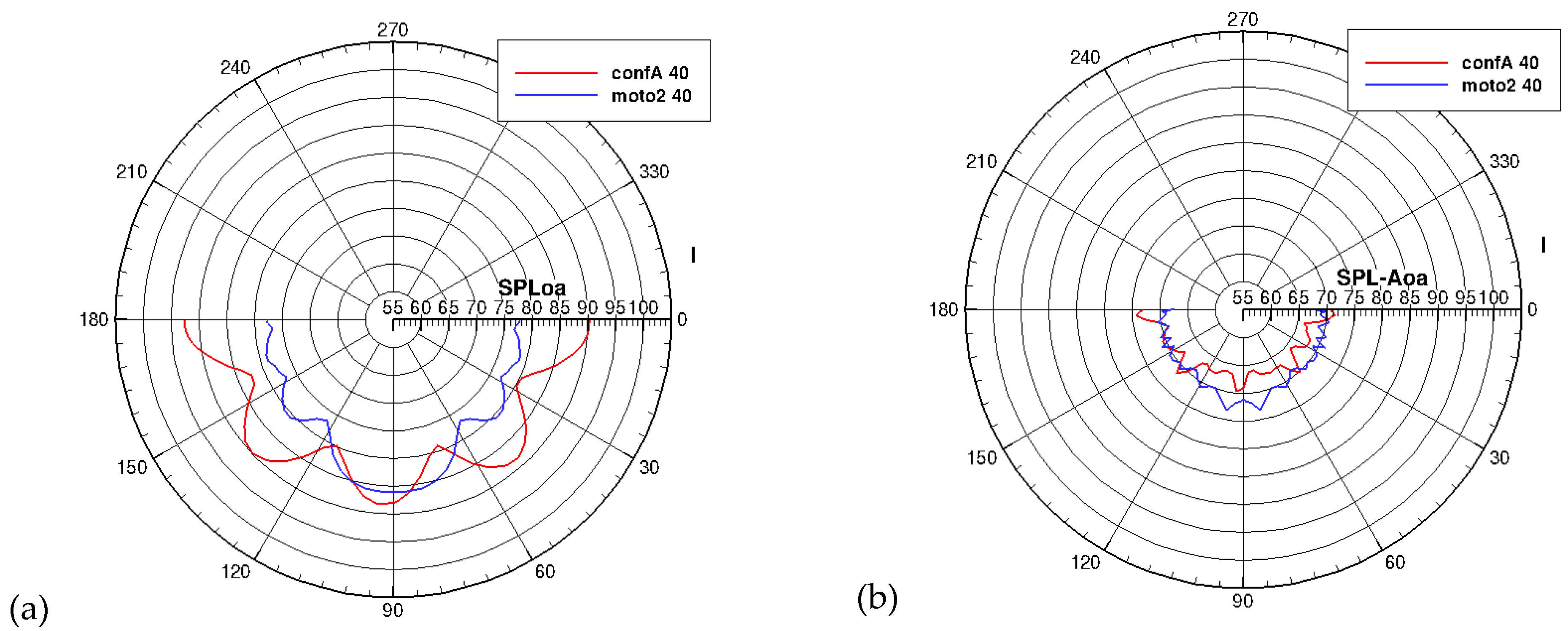

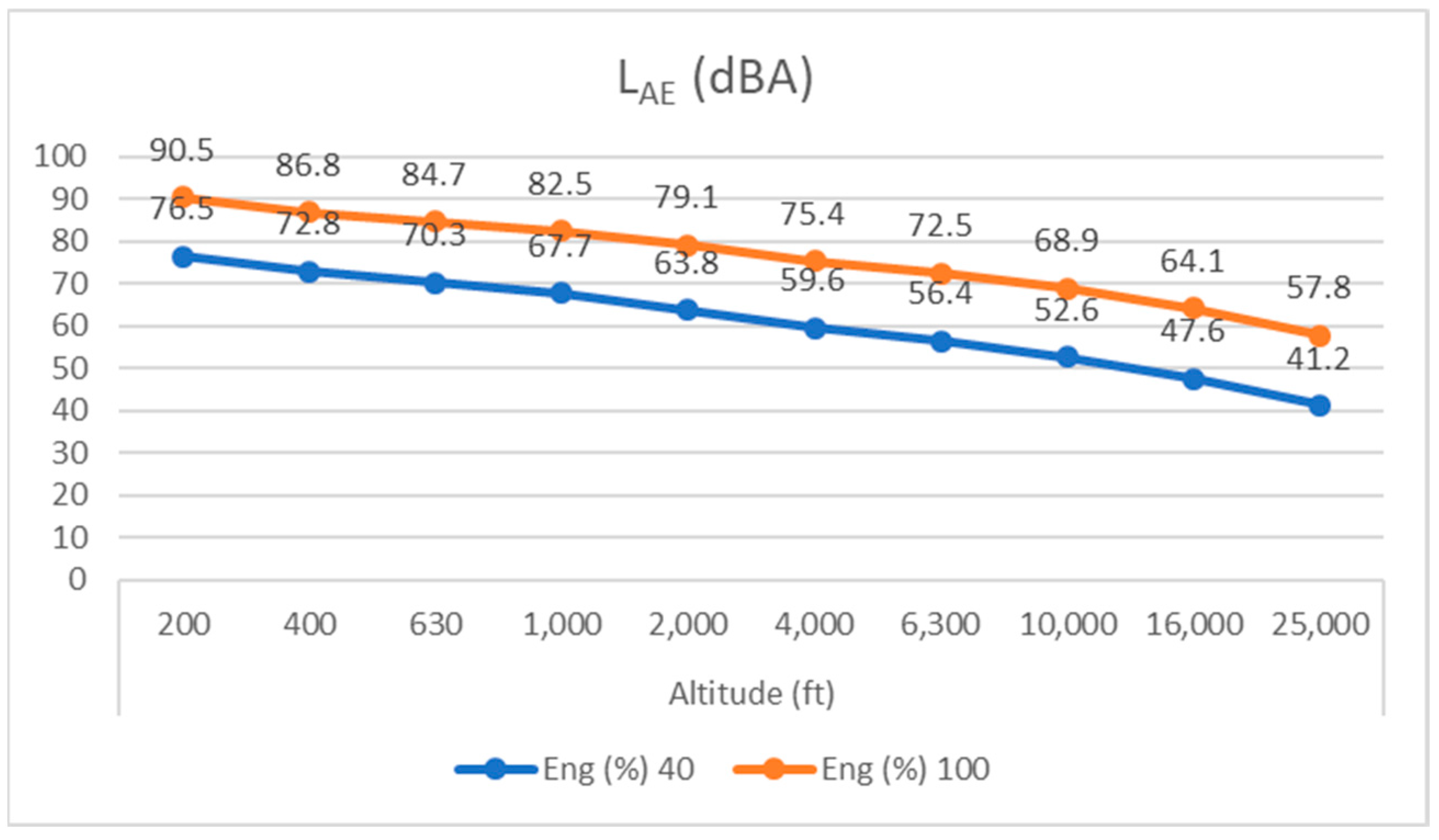
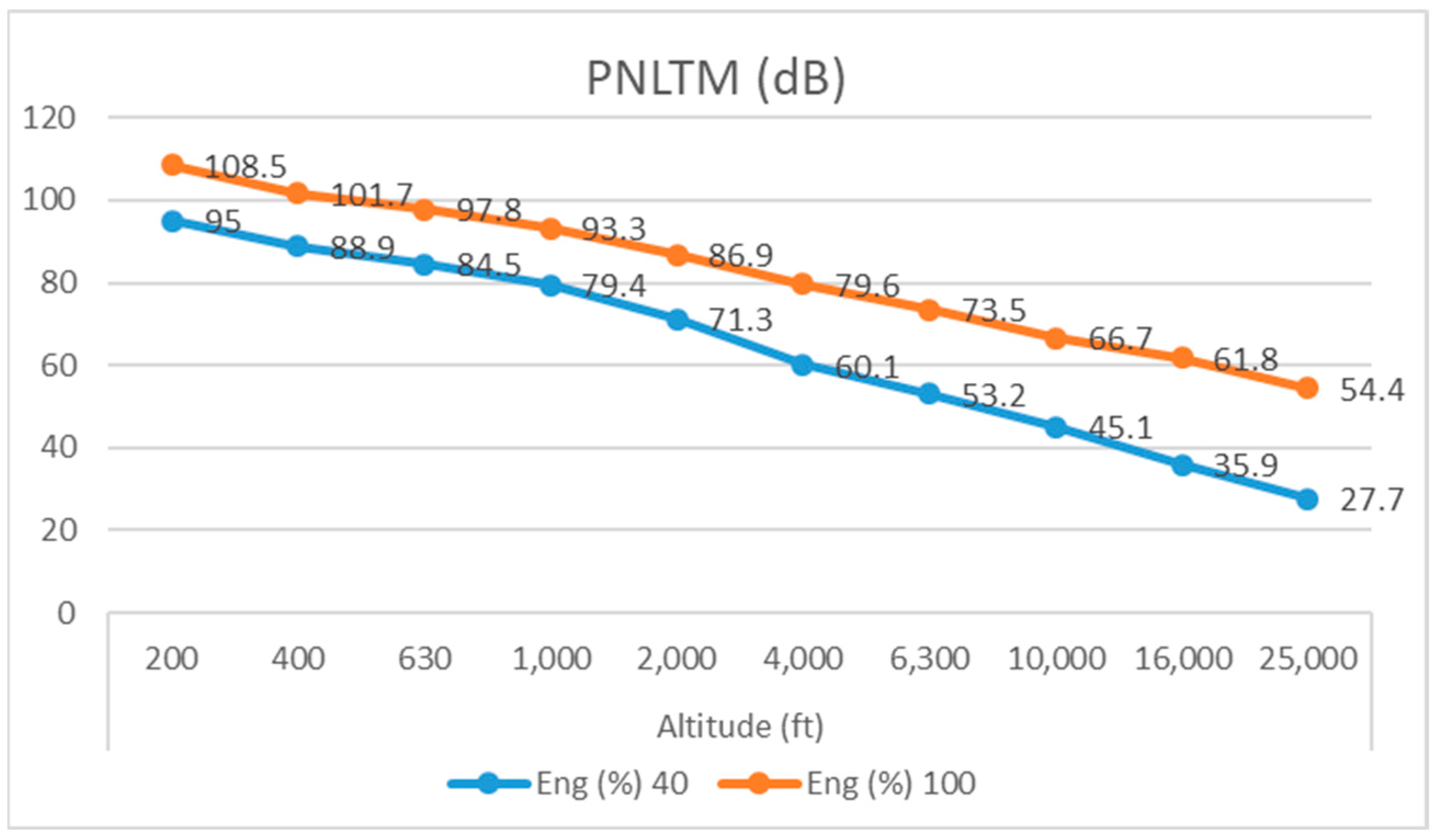
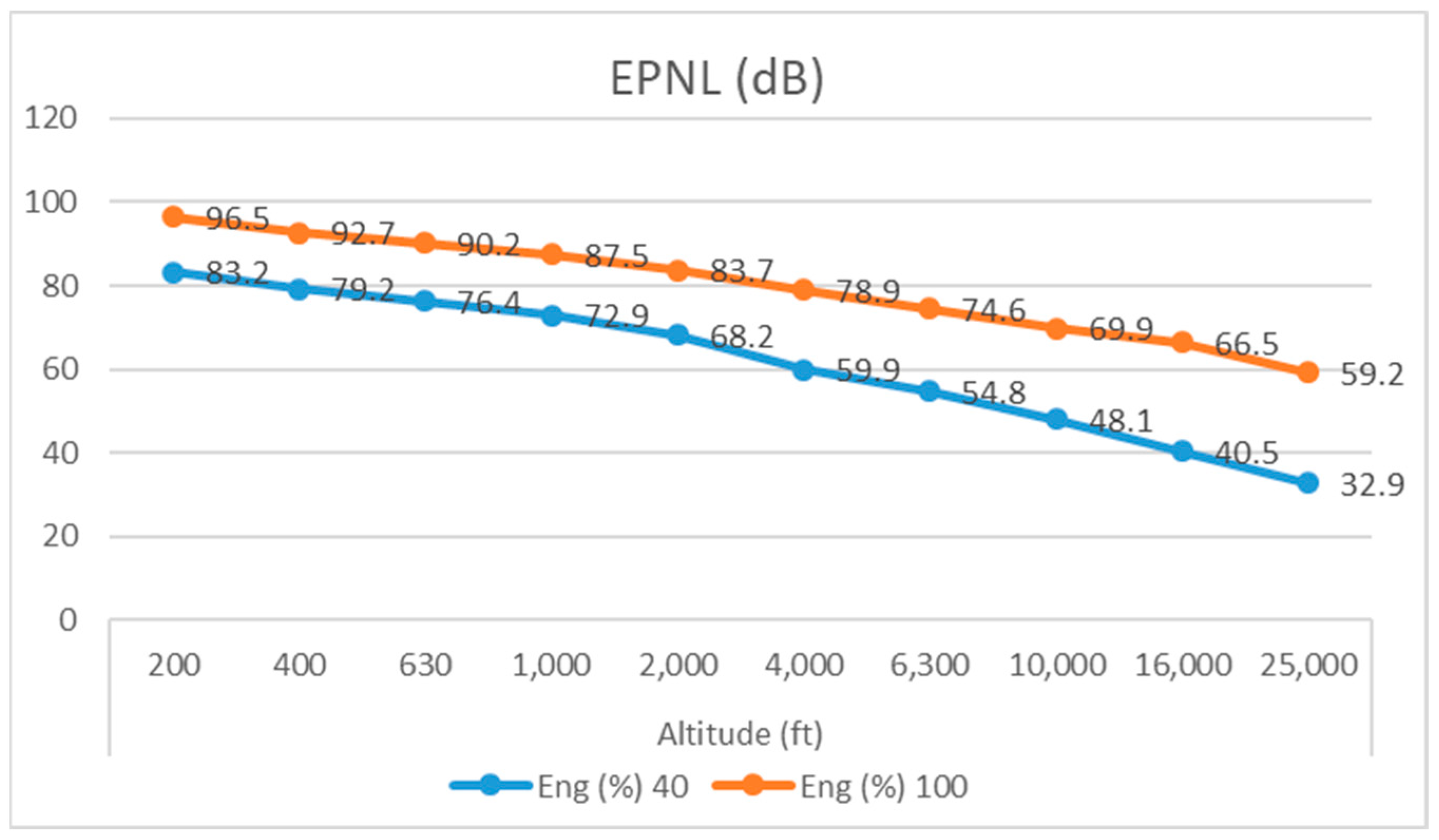
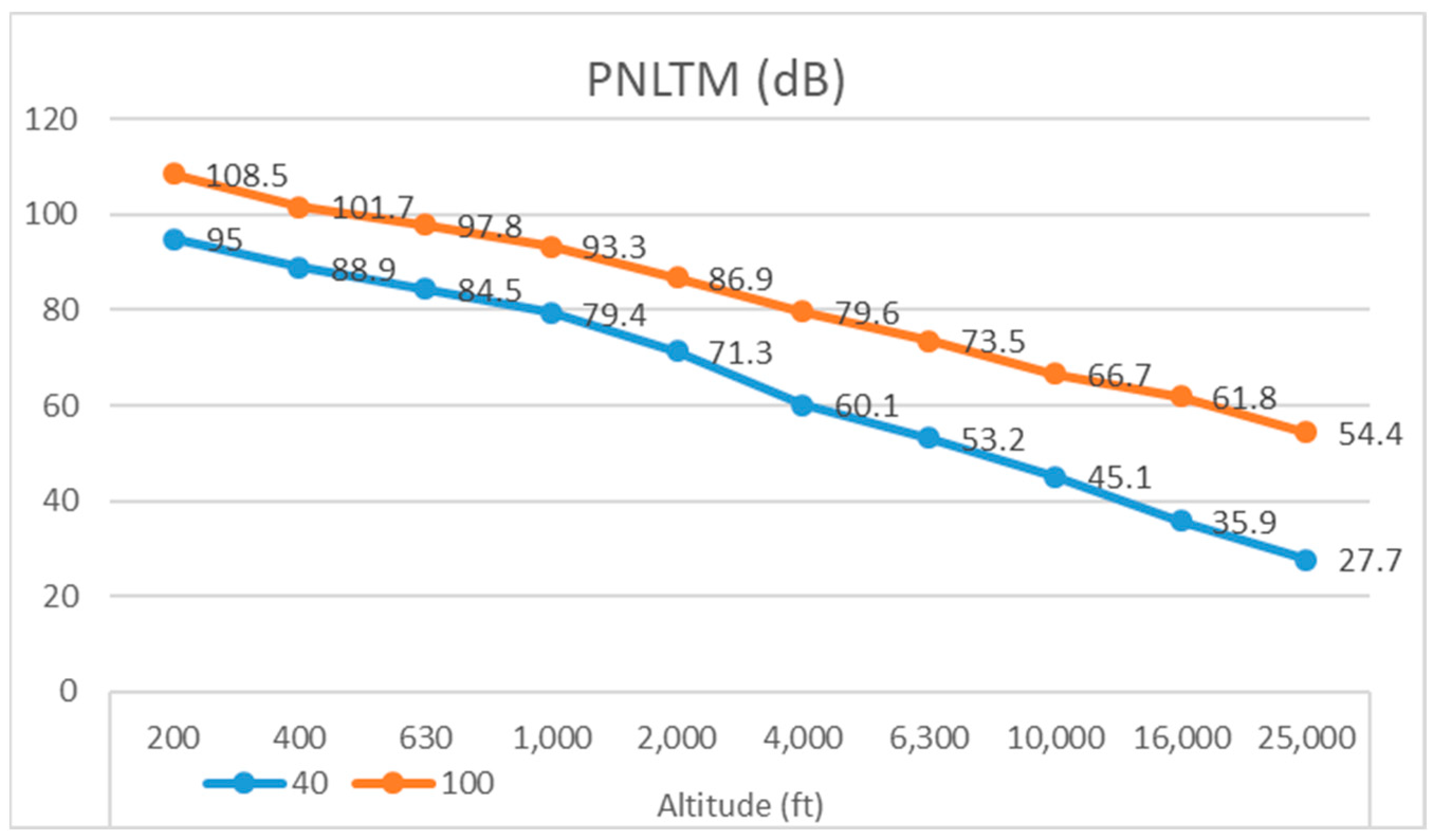
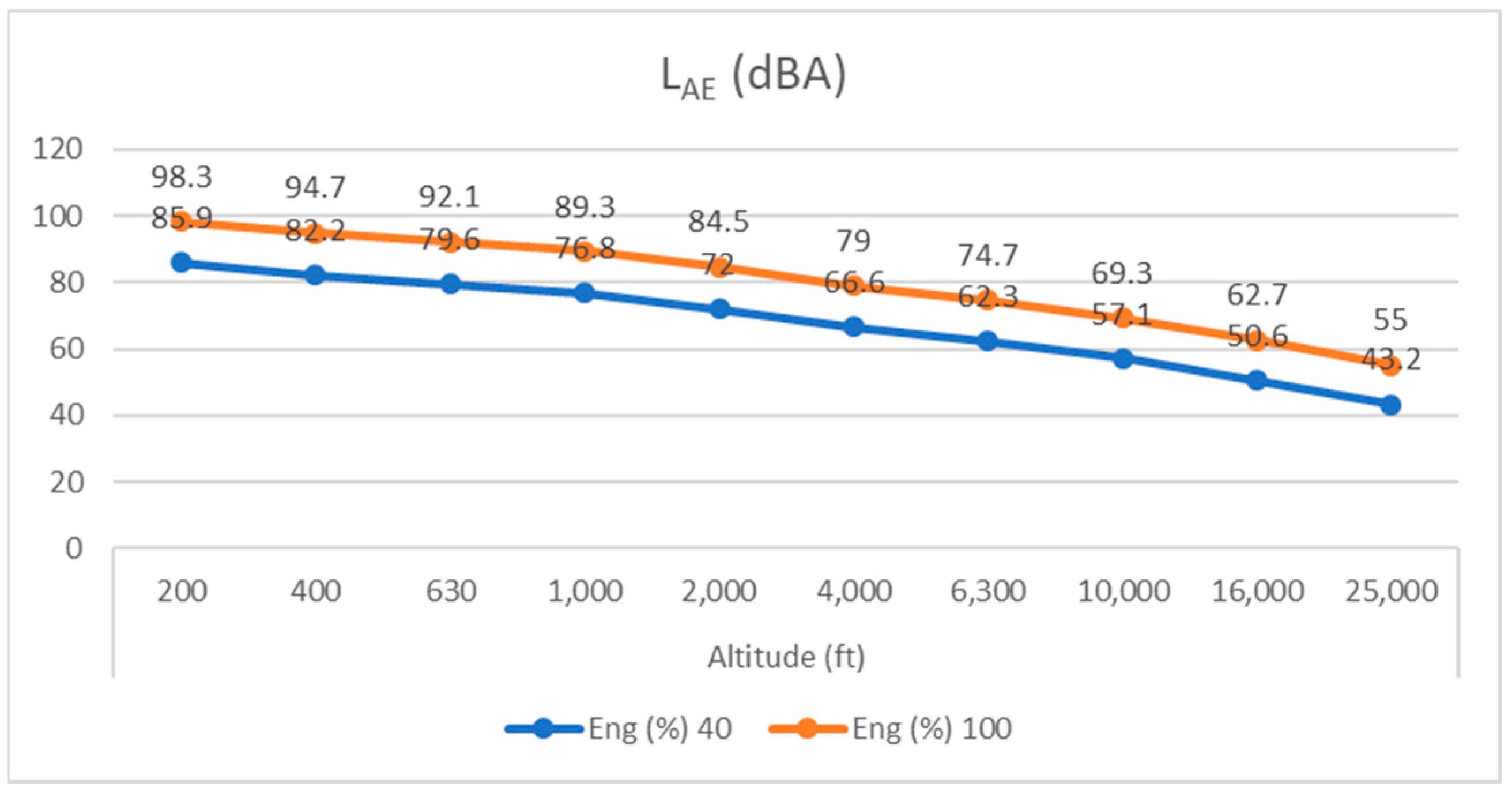
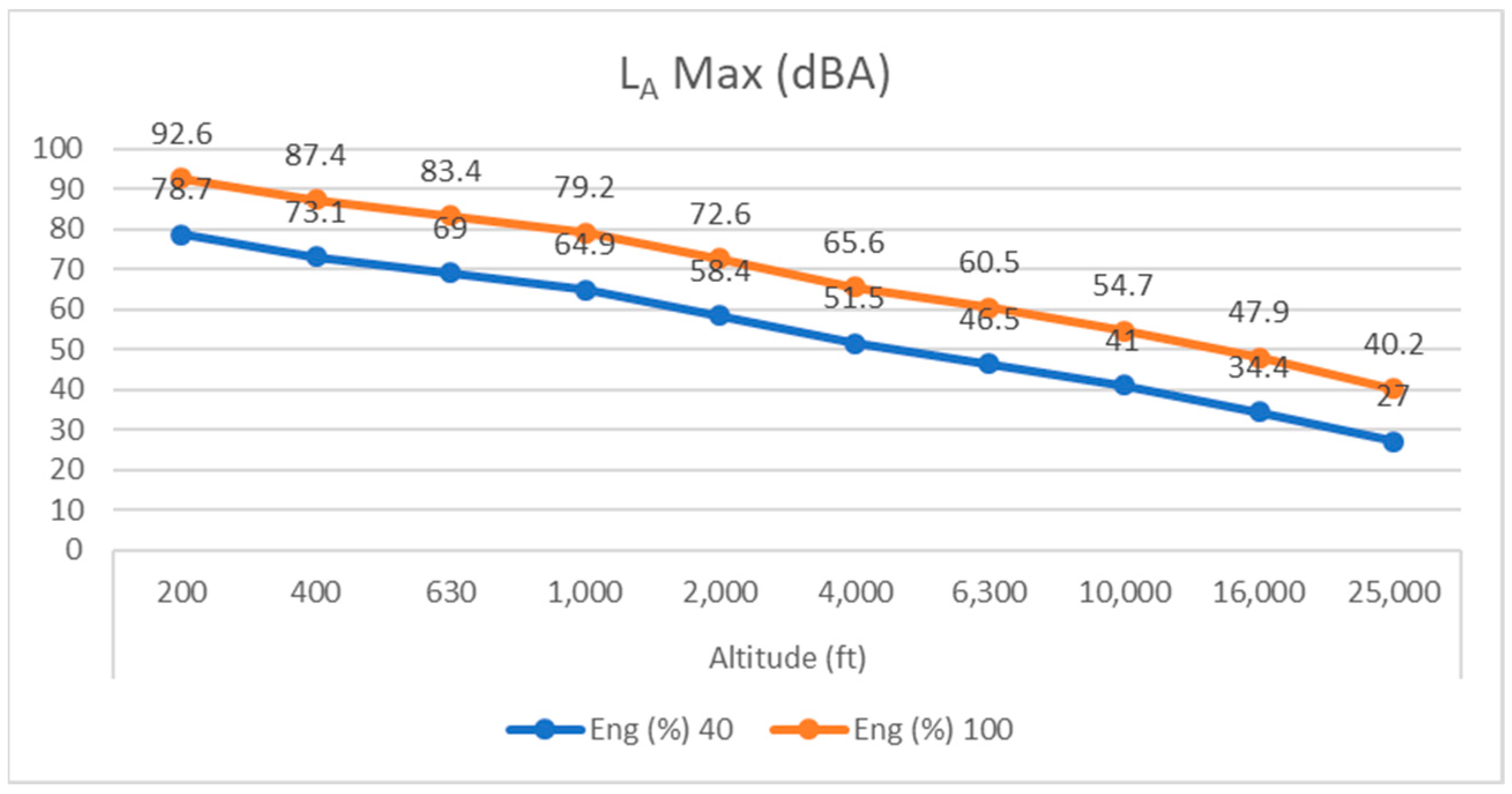
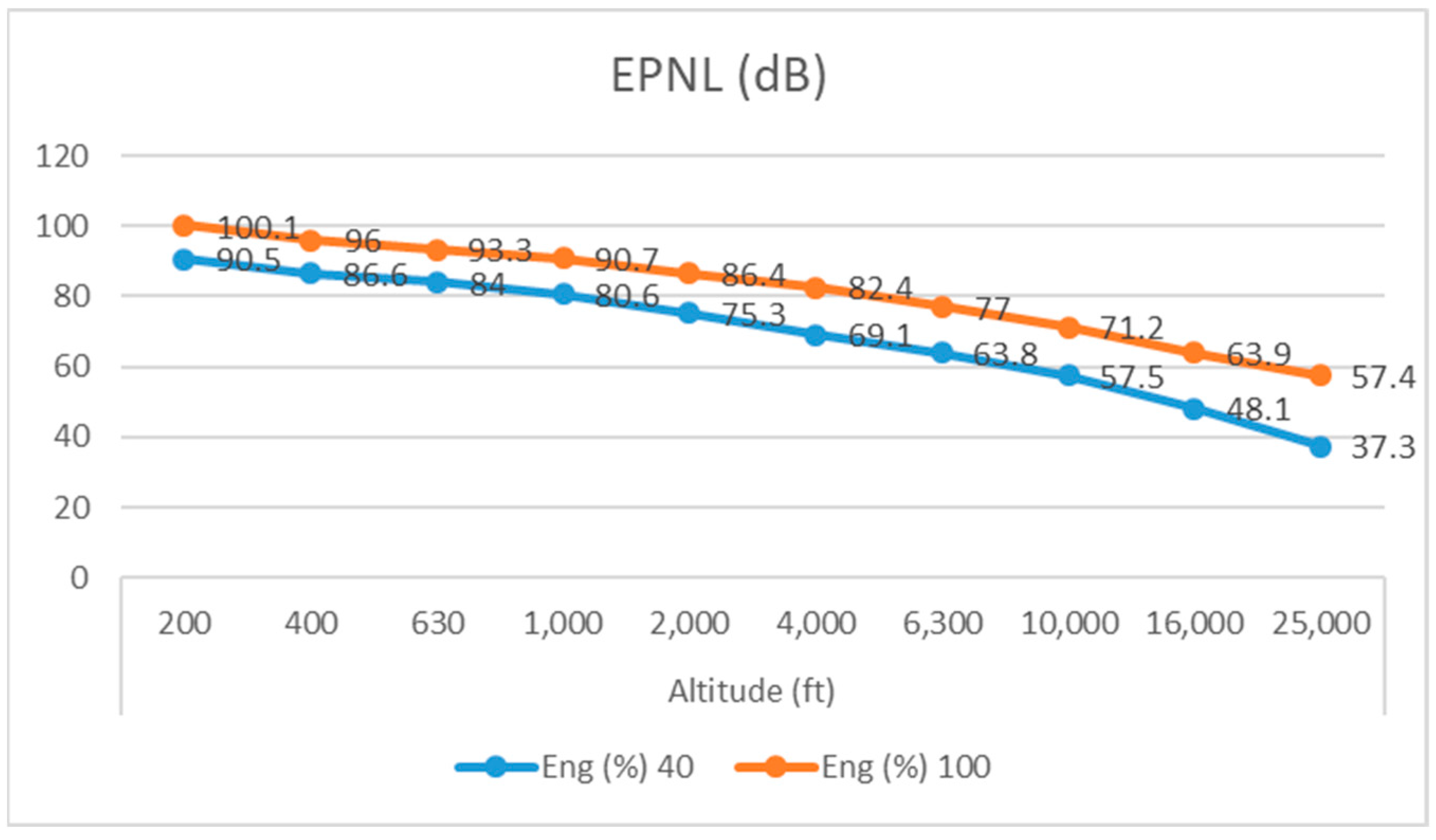
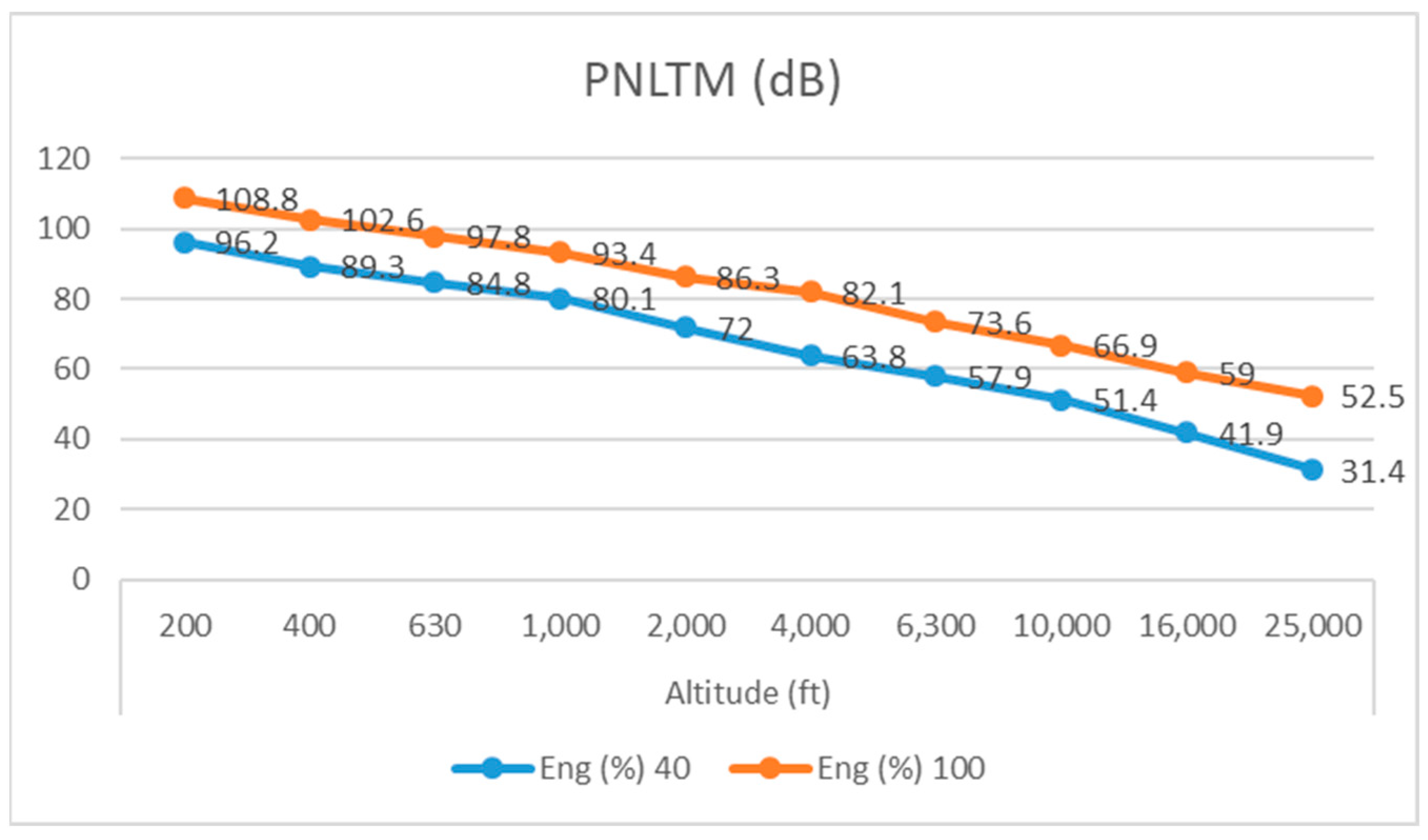
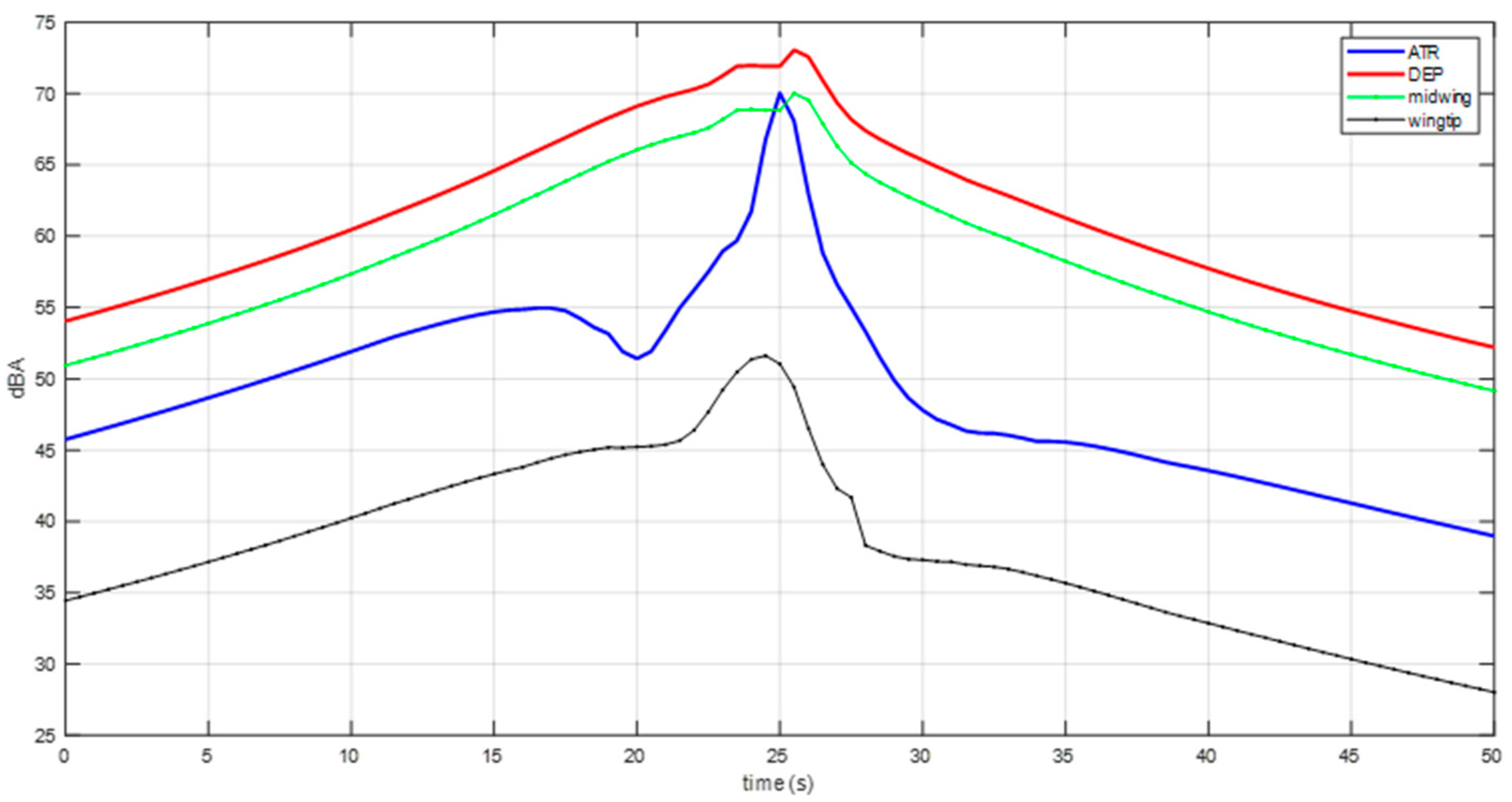
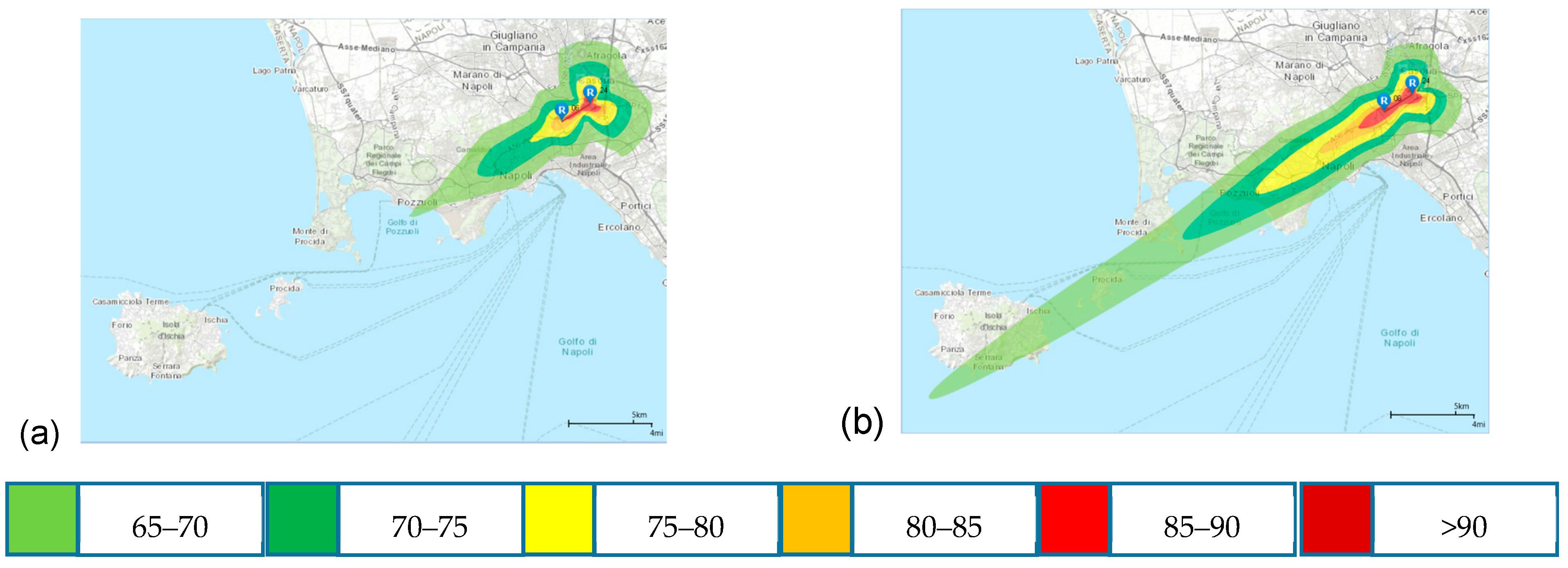
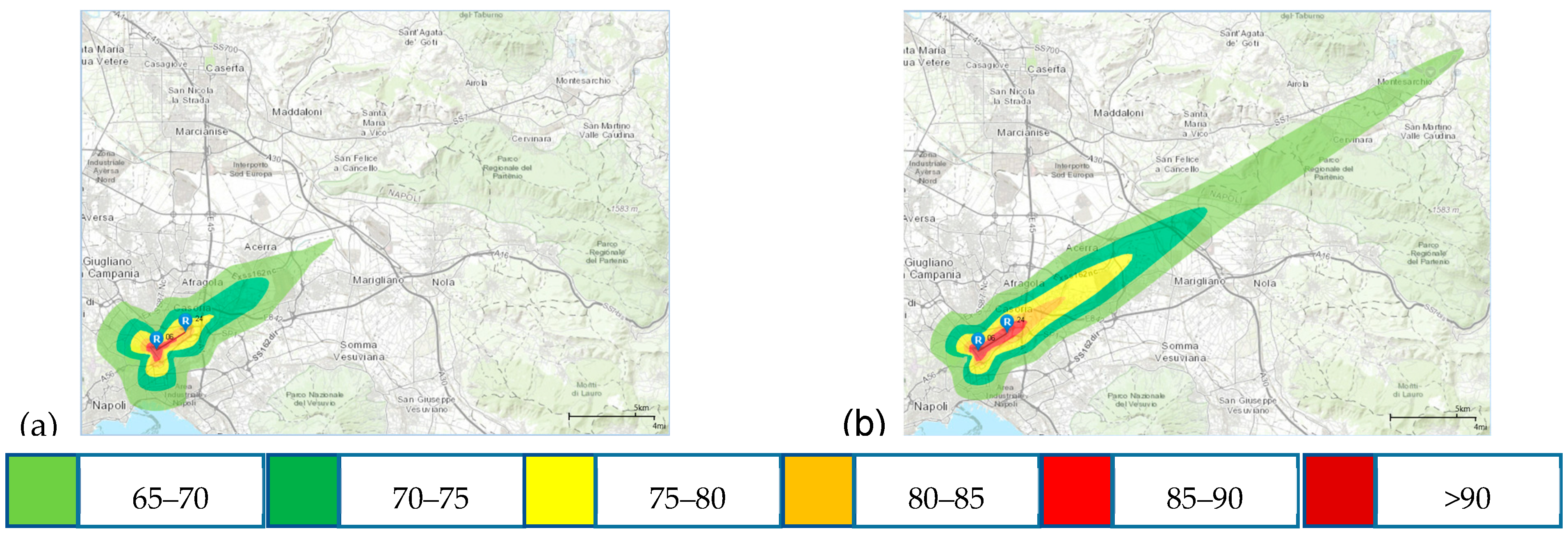
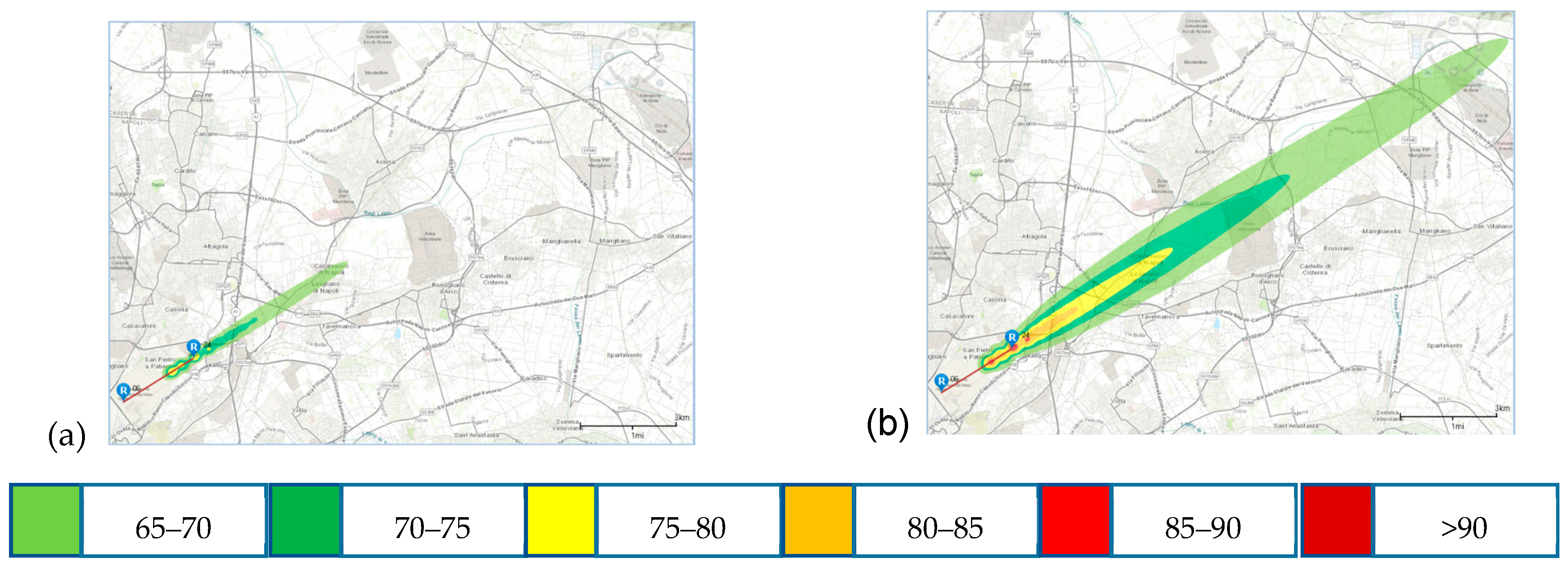

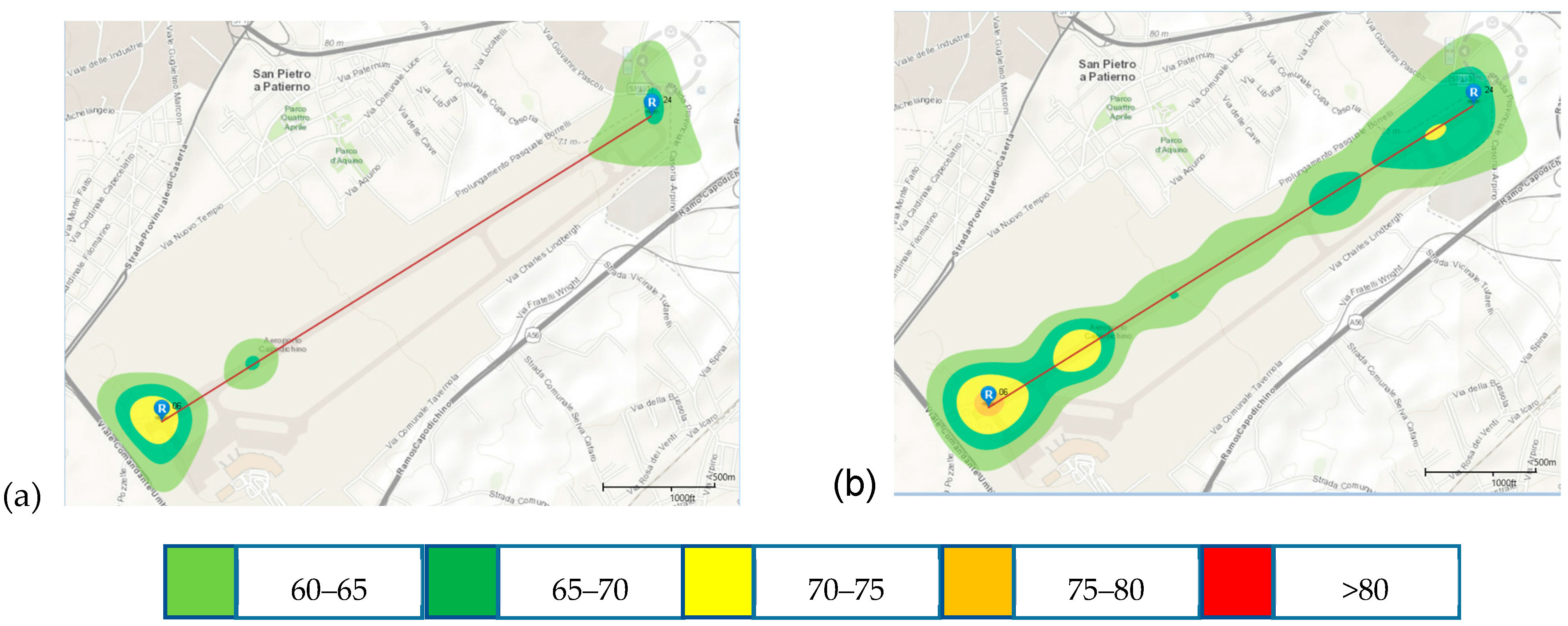
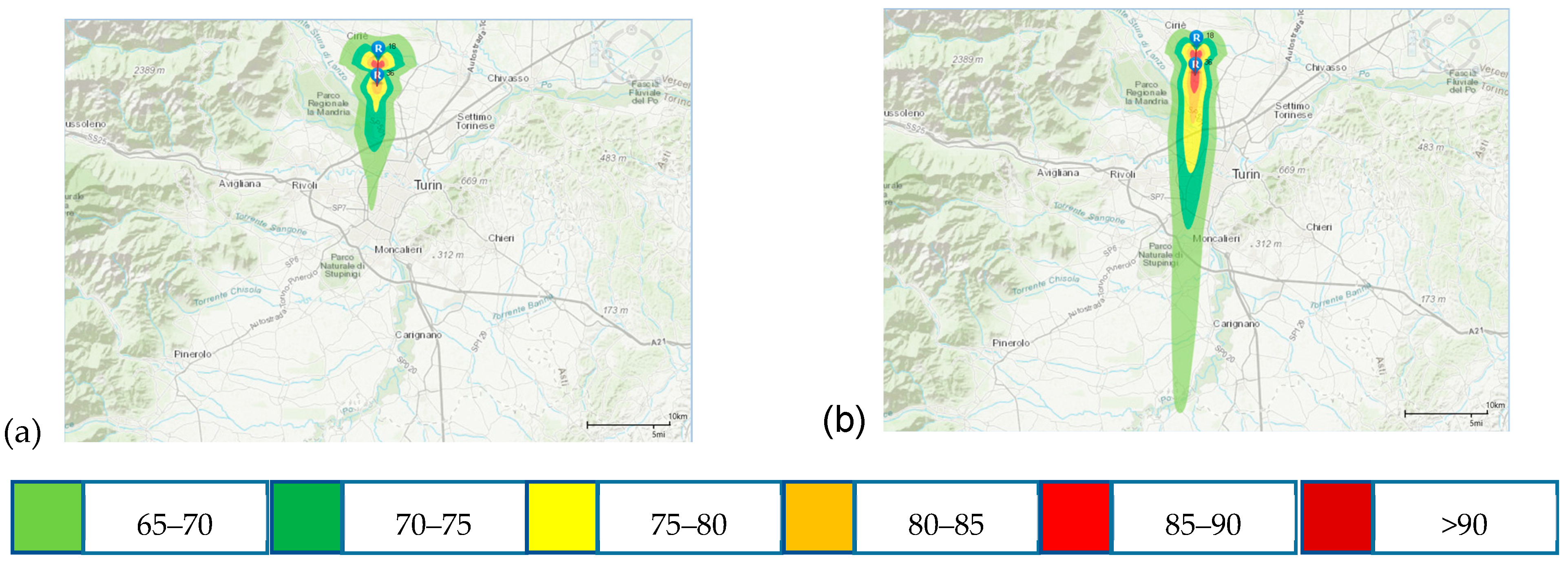

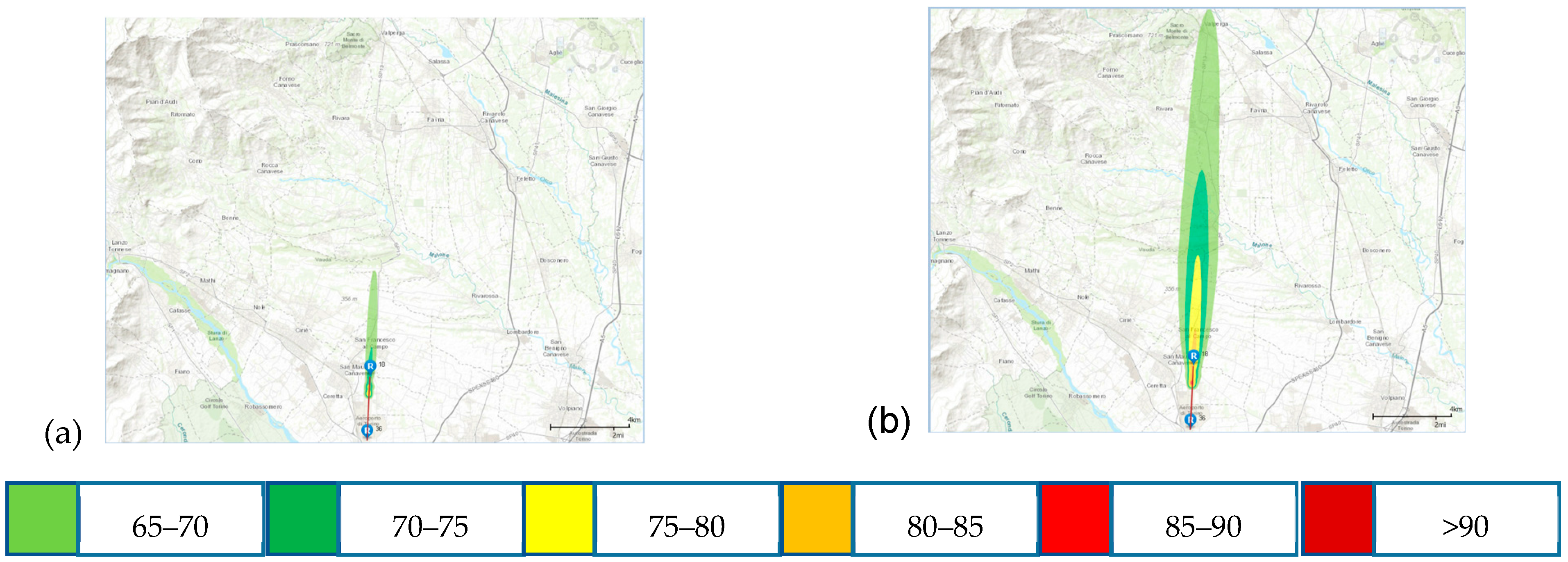


| LAE (dBA) | Altitude (ft) | ||||||||||
|---|---|---|---|---|---|---|---|---|---|---|---|
| 200 | 400 | 630 | 1000 | 2000 | 4000 | 6300 | 10,000 | 16,000 | 25,000 | ||
| Engine Power (%) | 35 | 88.9 | 84.4 | 81.1 | 77.7 | 71.9 | 65.8 | 62.3 | 58.7 | 55.6 | 52.8 |
| 40 | 91.8 | 87.8 | 84.8 | 81.5 | 76.2 | 70.8 | 67.4 | 63.7 | 59.9 | 56.1 | |
| 90 | 84.6 | 81.0 | 78.5 | 75.9 | 72.3 | 68.1 | 65.2 | 62.2 | 58.8 | 55.6 | |
| 100 | 87.0 | 83.5 | 81.4 | 79.1 | 75.4 | 71.5 | 68.7 | 65.9 | 62.7 | 59.6 | |
| 150 | 92.0 | 88.5 | 86.4 | 84.1 | 80.4 | 76.5 | 73.7 | 70.9 | 67.7 | 64.6 | |
| AoA [deg] | T [N] | T Total [N] | |
|---|---|---|---|
| Climb | 5.50 | 20,985 | 41,969.82 |
| Descent | −2.00 | 8394 | 16,787.93 |
| AoA [deg] | T Tip [N] | T DEP [N] | T Total [N] | |
|---|---|---|---|---|
| Climb | 9.00 | 2886 | 6493 | 57,718.22 |
| Descent | −2.00 | 1154 | 2597 | 23,087.29 |
| Propeller | RPM | Y Span [m] | θ0 [deg] |
|---|---|---|---|
| DEP 1 | 1520 | 2.5440 | 47.10 |
| DEP 2 | 1520 | 4.7685 | 47.08 |
| DEP 3 | 1520 | 6.9930 | 47.64 |
| DEP 4 | 1520 | 9.2175 | 47.90 |
| TIP | 1158 | 12.2900 | 19.88 |
| Propeller | RPM | Y Span [m] | θ0 [deg] |
|---|---|---|---|
| DEP 1 | 1160 | 2.5440 | 47.10 |
| DEP 2 | 1160 | 4.7685 | 47.08 |
| DEP 3 | 1160 | 6.9930 | 47.64 |
| DEP 4 | 1160 | 9.2175 | 47.90 |
| TIP | 1019 | 12.2900 | 22.10 |
| SPL Average [dB] | SPL-A Average [dB] | |
|---|---|---|
| Configuration A, 40% ETR | 85.117 | 66.967 |
| Motorization 2, 40% ETR | 84.269 | 72.189 |
| Configuration A, 100% ETR | 98.675 | 80.036 |
| Motorization 2, 100% ETR | 93.759 | 85.197 |
| Rw | Nr operations Day (6–20) | Nr Operations Evening (20–22) | Total Nr. of Operations | |
|---|---|---|---|---|
| Take-off | 24 | 3780 | 420 | 4200 |
| Landing | 24 | 3780 | 420 | 4200 |
| Take-off | 06 | 3780 | 420 | 4200 |
| Landing | 06 | 3780 | 420 | 4200 |
| Rw | Nr Operations Day (6–20) | Nr Operations Evening (20–22) | Total Nr. of Operations | |
|---|---|---|---|---|
| Take-off | 18 | 3780 | 420 | 4200 |
| Landing | 18 | 3780 | 420 | 4200 |
| Take-off | 36 | 3780 | 420 | 4200 |
| Landing | 36 | 3780 | 420 | 4200 |
Publisher’s Note: MDPI stays neutral with regard to jurisdictional claims in published maps and institutional affiliations. |
© 2021 by the authors. Licensee MDPI, Basel, Switzerland. This article is an open access article distributed under the terms and conditions of the Creative Commons Attribution (CC BY) license (https://creativecommons.org/licenses/by/4.0/).
Share and Cite
Sollazzo, A.; Petrosino, F.; De Vivo, L.; Visingardi, A.; Barbarino, M. Acoustic Impact of Hybrid-Electric DEP Aircraft Configuration at Airport Level. Appl. Sci. 2021, 11, 9664. https://doi.org/10.3390/app11209664
Sollazzo A, Petrosino F, De Vivo L, Visingardi A, Barbarino M. Acoustic Impact of Hybrid-Electric DEP Aircraft Configuration at Airport Level. Applied Sciences. 2021; 11(20):9664. https://doi.org/10.3390/app11209664
Chicago/Turabian StyleSollazzo, Adolfo, Francesco Petrosino, Luciano De Vivo, Antonio Visingardi, and Mattia Barbarino. 2021. "Acoustic Impact of Hybrid-Electric DEP Aircraft Configuration at Airport Level" Applied Sciences 11, no. 20: 9664. https://doi.org/10.3390/app11209664
APA StyleSollazzo, A., Petrosino, F., De Vivo, L., Visingardi, A., & Barbarino, M. (2021). Acoustic Impact of Hybrid-Electric DEP Aircraft Configuration at Airport Level. Applied Sciences, 11(20), 9664. https://doi.org/10.3390/app11209664







